International Strategic Marketing for Huia Wines
VerifiedAdded on 2022/12/23
|19
|5689
|1
AI Summary
This report analyzes strategies for entering international markets, focusing on India, China, and France. The report discusses market analysis, internal analysis, competitive strategy, market choice, and strategic objectives for Huia Wines. The company offers a variety of wine brands and adopts a multi-market strategy.
Contribute Materials
Your contribution can guide someone’s learning journey. Share your
documents today.
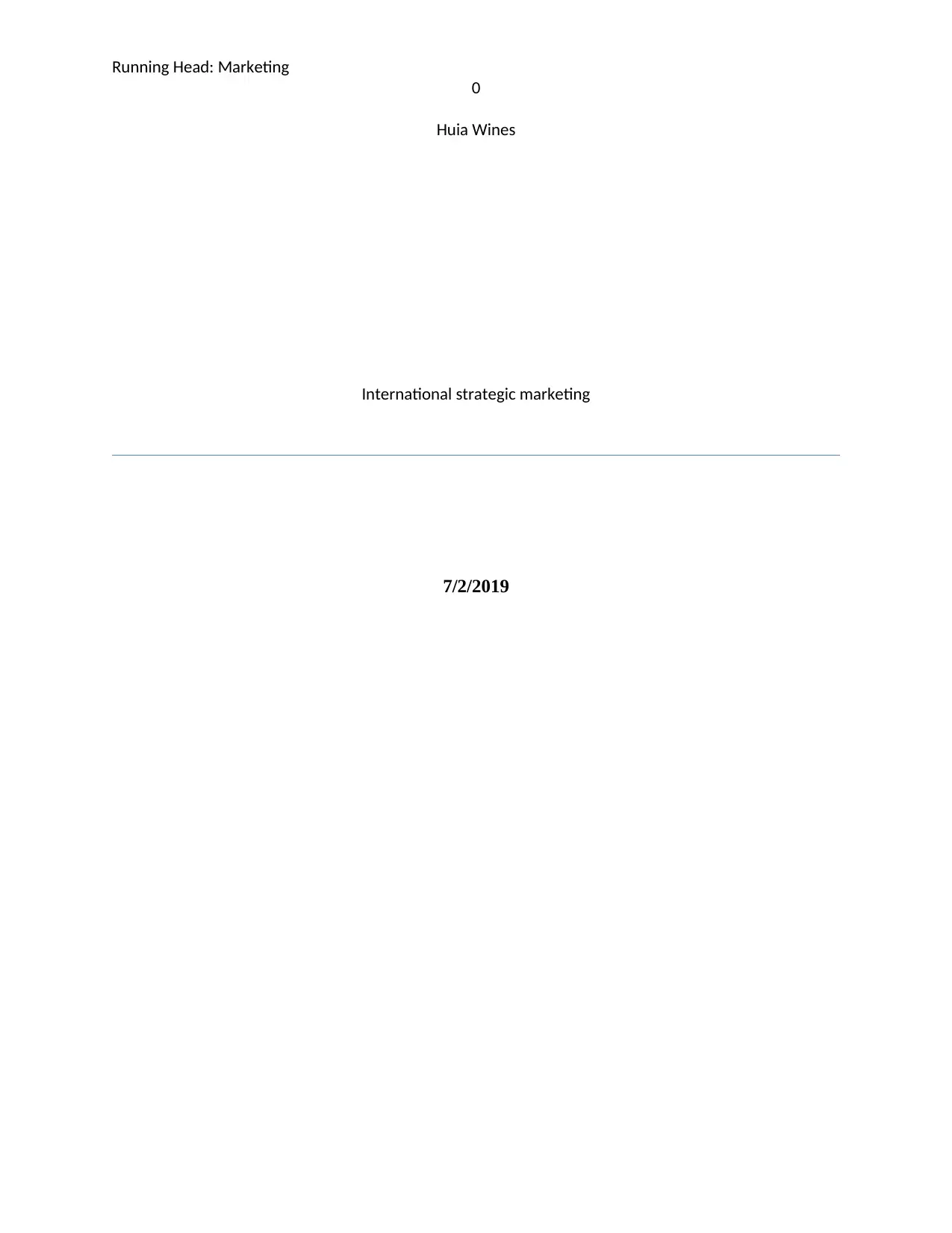
Running Head: Marketing
0
Huia Wines
International strategic marketing
7/2/2019
0
Huia Wines
International strategic marketing
7/2/2019
Secure Best Marks with AI Grader
Need help grading? Try our AI Grader for instant feedback on your assignments.
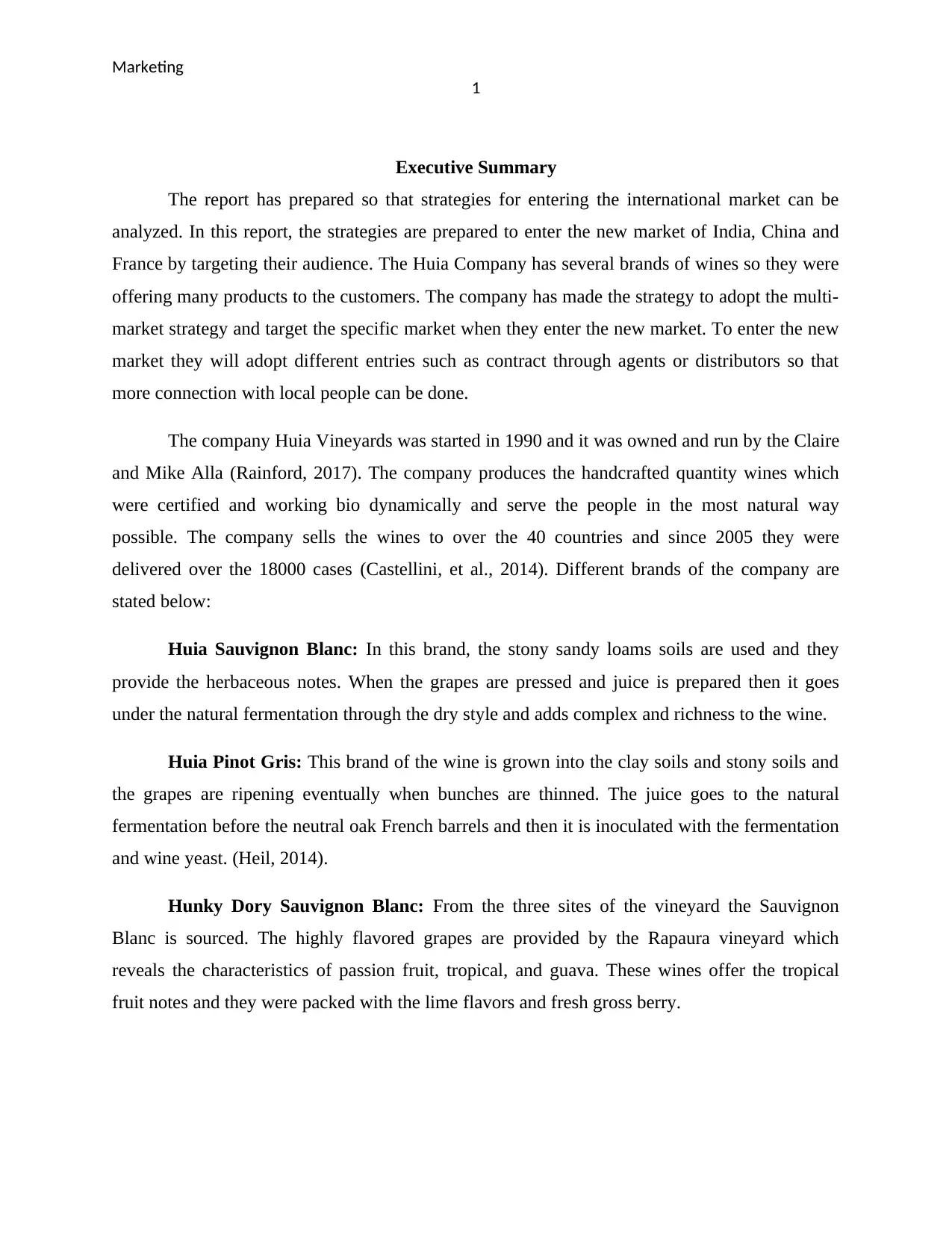
Marketing
1
Executive Summary
The report has prepared so that strategies for entering the international market can be
analyzed. In this report, the strategies are prepared to enter the new market of India, China and
France by targeting their audience. The Huia Company has several brands of wines so they were
offering many products to the customers. The company has made the strategy to adopt the multi-
market strategy and target the specific market when they enter the new market. To enter the new
market they will adopt different entries such as contract through agents or distributors so that
more connection with local people can be done.
The company Huia Vineyards was started in 1990 and it was owned and run by the Claire
and Mike Alla (Rainford, 2017). The company produces the handcrafted quantity wines which
were certified and working bio dynamically and serve the people in the most natural way
possible. The company sells the wines to over the 40 countries and since 2005 they were
delivered over the 18000 cases (Castellini, et al., 2014). Different brands of the company are
stated below:
Huia Sauvignon Blanc: In this brand, the stony sandy loams soils are used and they
provide the herbaceous notes. When the grapes are pressed and juice is prepared then it goes
under the natural fermentation through the dry style and adds complex and richness to the wine.
Huia Pinot Gris: This brand of the wine is grown into the clay soils and stony soils and
the grapes are ripening eventually when bunches are thinned. The juice goes to the natural
fermentation before the neutral oak French barrels and then it is inoculated with the fermentation
and wine yeast. (Heil, 2014).
Hunky Dory Sauvignon Blanc: From the three sites of the vineyard the Sauvignon
Blanc is sourced. The highly flavored grapes are provided by the Rapaura vineyard which
reveals the characteristics of passion fruit, tropical, and guava. These wines offer the tropical
fruit notes and they were packed with the lime flavors and fresh gross berry.
1
Executive Summary
The report has prepared so that strategies for entering the international market can be
analyzed. In this report, the strategies are prepared to enter the new market of India, China and
France by targeting their audience. The Huia Company has several brands of wines so they were
offering many products to the customers. The company has made the strategy to adopt the multi-
market strategy and target the specific market when they enter the new market. To enter the new
market they will adopt different entries such as contract through agents or distributors so that
more connection with local people can be done.
The company Huia Vineyards was started in 1990 and it was owned and run by the Claire
and Mike Alla (Rainford, 2017). The company produces the handcrafted quantity wines which
were certified and working bio dynamically and serve the people in the most natural way
possible. The company sells the wines to over the 40 countries and since 2005 they were
delivered over the 18000 cases (Castellini, et al., 2014). Different brands of the company are
stated below:
Huia Sauvignon Blanc: In this brand, the stony sandy loams soils are used and they
provide the herbaceous notes. When the grapes are pressed and juice is prepared then it goes
under the natural fermentation through the dry style and adds complex and richness to the wine.
Huia Pinot Gris: This brand of the wine is grown into the clay soils and stony soils and
the grapes are ripening eventually when bunches are thinned. The juice goes to the natural
fermentation before the neutral oak French barrels and then it is inoculated with the fermentation
and wine yeast. (Heil, 2014).
Hunky Dory Sauvignon Blanc: From the three sites of the vineyard the Sauvignon
Blanc is sourced. The highly flavored grapes are provided by the Rapaura vineyard which
reveals the characteristics of passion fruit, tropical, and guava. These wines offer the tropical
fruit notes and they were packed with the lime flavors and fresh gross berry.
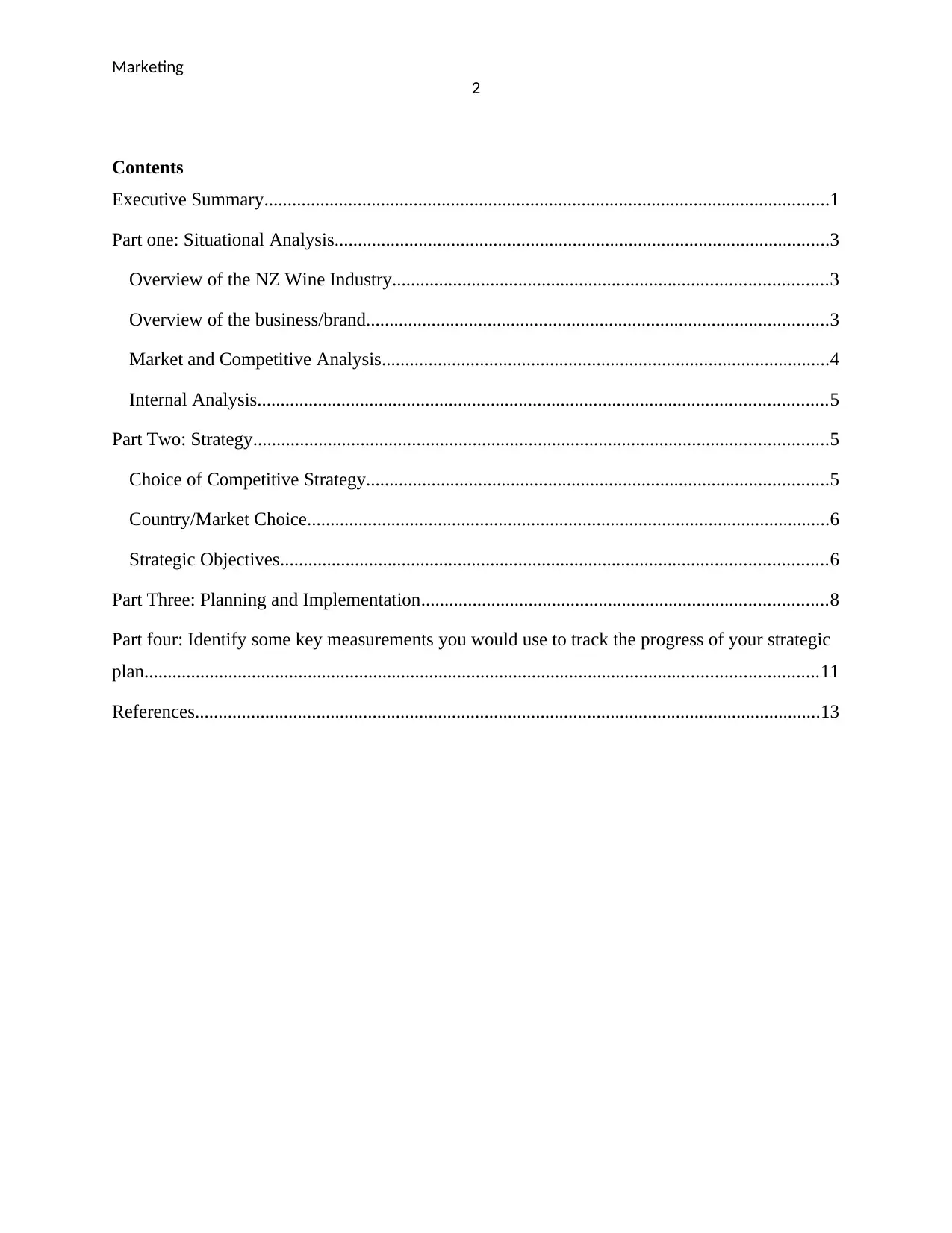
Marketing
2
Contents
Executive Summary.........................................................................................................................1
Part one: Situational Analysis..........................................................................................................3
Overview of the NZ Wine Industry.............................................................................................3
Overview of the business/brand...................................................................................................3
Market and Competitive Analysis................................................................................................4
Internal Analysis..........................................................................................................................5
Part Two: Strategy...........................................................................................................................5
Choice of Competitive Strategy...................................................................................................5
Country/Market Choice................................................................................................................6
Strategic Objectives.....................................................................................................................6
Part Three: Planning and Implementation.......................................................................................8
Part four: Identify some key measurements you would use to track the progress of your strategic
plan................................................................................................................................................11
References......................................................................................................................................13
2
Contents
Executive Summary.........................................................................................................................1
Part one: Situational Analysis..........................................................................................................3
Overview of the NZ Wine Industry.............................................................................................3
Overview of the business/brand...................................................................................................3
Market and Competitive Analysis................................................................................................4
Internal Analysis..........................................................................................................................5
Part Two: Strategy...........................................................................................................................5
Choice of Competitive Strategy...................................................................................................5
Country/Market Choice................................................................................................................6
Strategic Objectives.....................................................................................................................6
Part Three: Planning and Implementation.......................................................................................8
Part four: Identify some key measurements you would use to track the progress of your strategic
plan................................................................................................................................................11
References......................................................................................................................................13
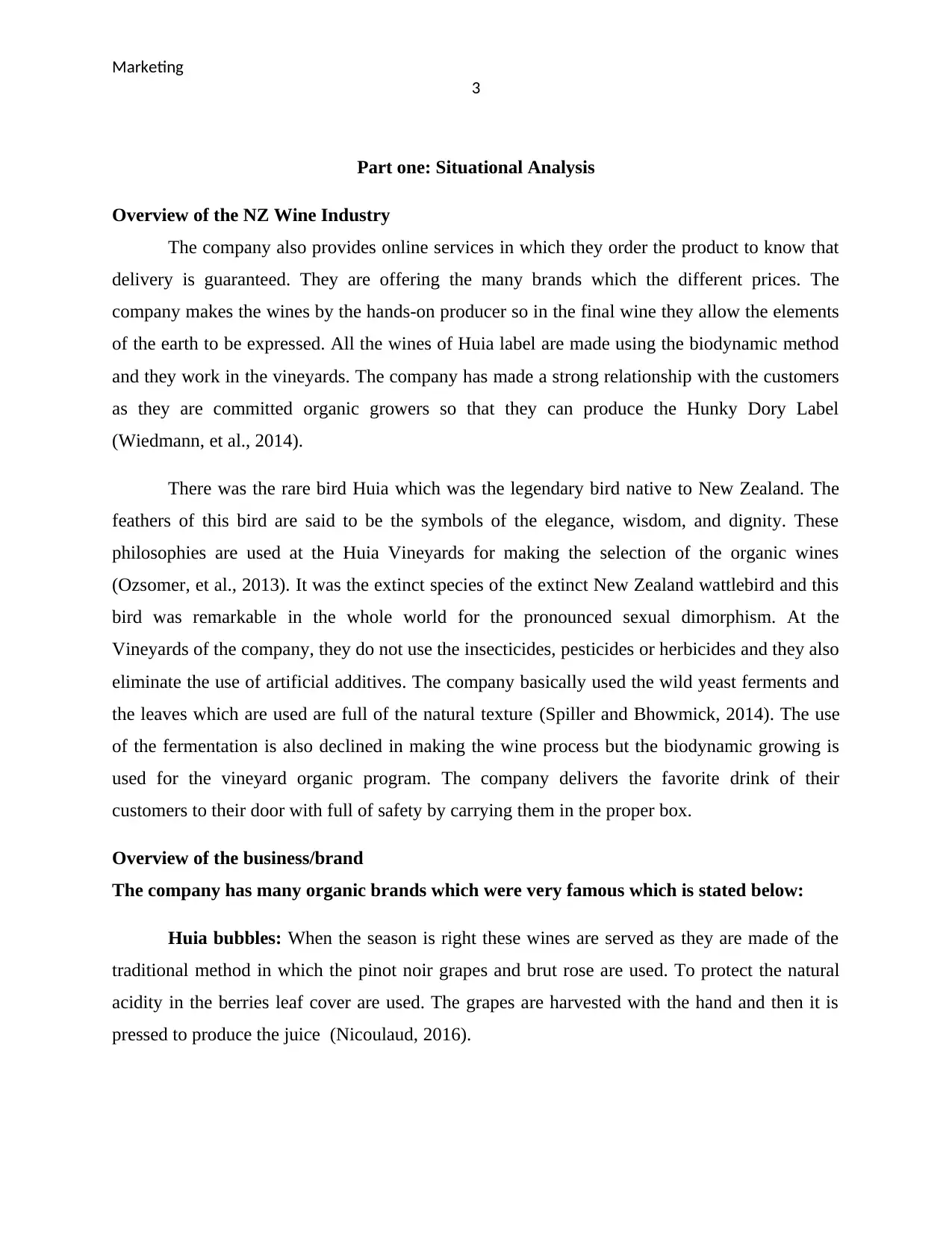
Marketing
3
Part one: Situational Analysis
Overview of the NZ Wine Industry
The company also provides online services in which they order the product to know that
delivery is guaranteed. They are offering the many brands which the different prices. The
company makes the wines by the hands-on producer so in the final wine they allow the elements
of the earth to be expressed. All the wines of Huia label are made using the biodynamic method
and they work in the vineyards. The company has made a strong relationship with the customers
as they are committed organic growers so that they can produce the Hunky Dory Label
(Wiedmann, et al., 2014).
There was the rare bird Huia which was the legendary bird native to New Zealand. The
feathers of this bird are said to be the symbols of the elegance, wisdom, and dignity. These
philosophies are used at the Huia Vineyards for making the selection of the organic wines
(Ozsomer, et al., 2013). It was the extinct species of the extinct New Zealand wattlebird and this
bird was remarkable in the whole world for the pronounced sexual dimorphism. At the
Vineyards of the company, they do not use the insecticides, pesticides or herbicides and they also
eliminate the use of artificial additives. The company basically used the wild yeast ferments and
the leaves which are used are full of the natural texture (Spiller and Bhowmick, 2014). The use
of the fermentation is also declined in making the wine process but the biodynamic growing is
used for the vineyard organic program. The company delivers the favorite drink of their
customers to their door with full of safety by carrying them in the proper box.
Overview of the business/brand
The company has many organic brands which were very famous which is stated below:
Huia bubbles: When the season is right these wines are served as they are made of the
traditional method in which the pinot noir grapes and brut rose are used. To protect the natural
acidity in the berries leaf cover are used. The grapes are harvested with the hand and then it is
pressed to produce the juice (Nicoulaud, 2016).
3
Part one: Situational Analysis
Overview of the NZ Wine Industry
The company also provides online services in which they order the product to know that
delivery is guaranteed. They are offering the many brands which the different prices. The
company makes the wines by the hands-on producer so in the final wine they allow the elements
of the earth to be expressed. All the wines of Huia label are made using the biodynamic method
and they work in the vineyards. The company has made a strong relationship with the customers
as they are committed organic growers so that they can produce the Hunky Dory Label
(Wiedmann, et al., 2014).
There was the rare bird Huia which was the legendary bird native to New Zealand. The
feathers of this bird are said to be the symbols of the elegance, wisdom, and dignity. These
philosophies are used at the Huia Vineyards for making the selection of the organic wines
(Ozsomer, et al., 2013). It was the extinct species of the extinct New Zealand wattlebird and this
bird was remarkable in the whole world for the pronounced sexual dimorphism. At the
Vineyards of the company, they do not use the insecticides, pesticides or herbicides and they also
eliminate the use of artificial additives. The company basically used the wild yeast ferments and
the leaves which are used are full of the natural texture (Spiller and Bhowmick, 2014). The use
of the fermentation is also declined in making the wine process but the biodynamic growing is
used for the vineyard organic program. The company delivers the favorite drink of their
customers to their door with full of safety by carrying them in the proper box.
Overview of the business/brand
The company has many organic brands which were very famous which is stated below:
Huia bubbles: When the season is right these wines are served as they are made of the
traditional method in which the pinot noir grapes and brut rose are used. To protect the natural
acidity in the berries leaf cover are used. The grapes are harvested with the hand and then it is
pressed to produce the juice (Nicoulaud, 2016).
Secure Best Marks with AI Grader
Need help grading? Try our AI Grader for instant feedback on your assignments.
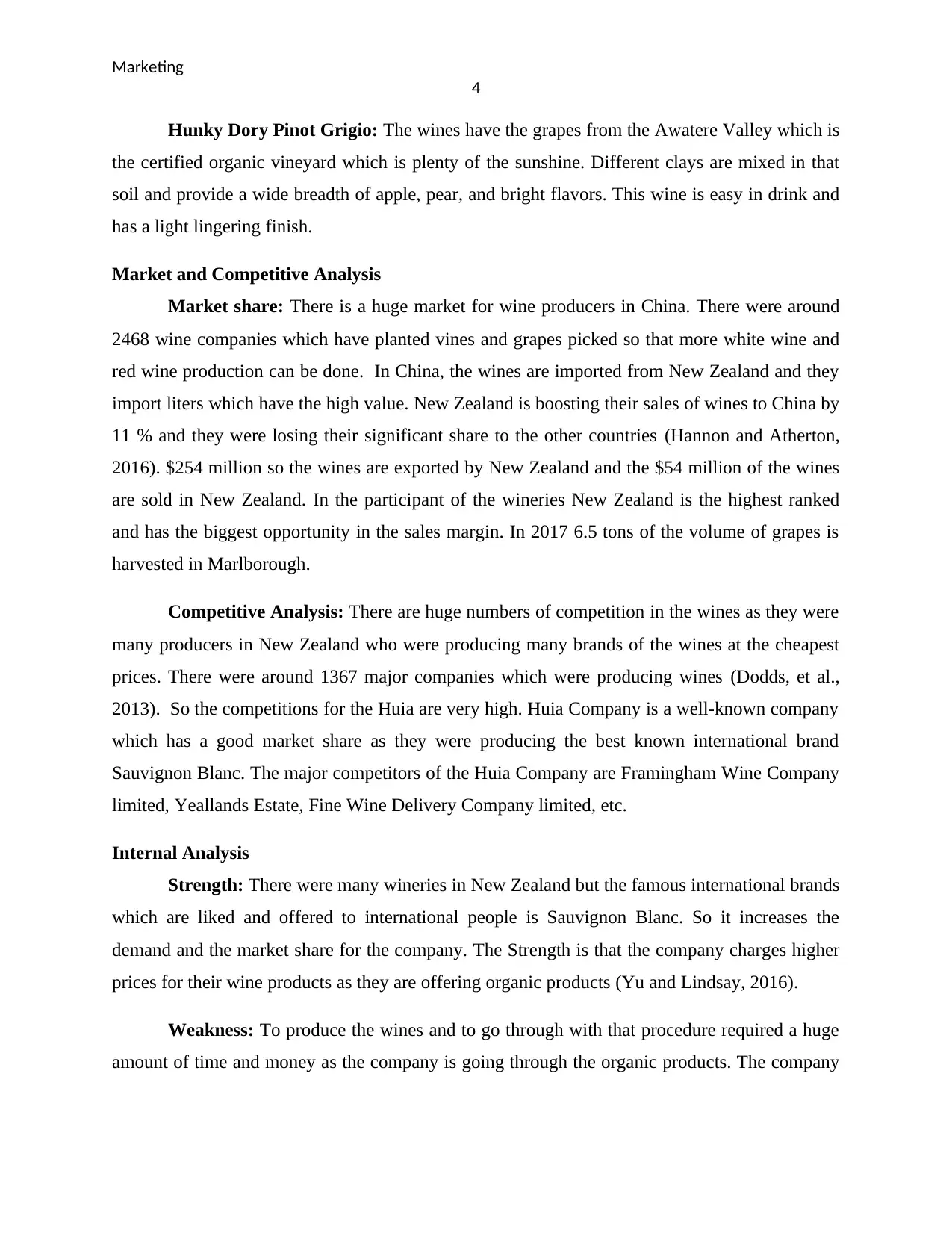
Marketing
4
Hunky Dory Pinot Grigio: The wines have the grapes from the Awatere Valley which is
the certified organic vineyard which is plenty of the sunshine. Different clays are mixed in that
soil and provide a wide breadth of apple, pear, and bright flavors. This wine is easy in drink and
has a light lingering finish.
Market and Competitive Analysis
Market share: There is a huge market for wine producers in China. There were around
2468 wine companies which have planted vines and grapes picked so that more white wine and
red wine production can be done. In China, the wines are imported from New Zealand and they
import liters which have the high value. New Zealand is boosting their sales of wines to China by
11 % and they were losing their significant share to the other countries (Hannon and Atherton,
2016). $254 million so the wines are exported by New Zealand and the $54 million of the wines
are sold in New Zealand. In the participant of the wineries New Zealand is the highest ranked
and has the biggest opportunity in the sales margin. In 2017 6.5 tons of the volume of grapes is
harvested in Marlborough.
Competitive Analysis: There are huge numbers of competition in the wines as they were
many producers in New Zealand who were producing many brands of the wines at the cheapest
prices. There were around 1367 major companies which were producing wines (Dodds, et al.,
2013). So the competitions for the Huia are very high. Huia Company is a well-known company
which has a good market share as they were producing the best known international brand
Sauvignon Blanc. The major competitors of the Huia Company are Framingham Wine Company
limited, Yeallands Estate, Fine Wine Delivery Company limited, etc.
Internal Analysis
Strength: There were many wineries in New Zealand but the famous international brands
which are liked and offered to international people is Sauvignon Blanc. So it increases the
demand and the market share for the company. The Strength is that the company charges higher
prices for their wine products as they are offering organic products (Yu and Lindsay, 2016).
Weakness: To produce the wines and to go through with that procedure required a huge
amount of time and money as the company is going through the organic products. The company
4
Hunky Dory Pinot Grigio: The wines have the grapes from the Awatere Valley which is
the certified organic vineyard which is plenty of the sunshine. Different clays are mixed in that
soil and provide a wide breadth of apple, pear, and bright flavors. This wine is easy in drink and
has a light lingering finish.
Market and Competitive Analysis
Market share: There is a huge market for wine producers in China. There were around
2468 wine companies which have planted vines and grapes picked so that more white wine and
red wine production can be done. In China, the wines are imported from New Zealand and they
import liters which have the high value. New Zealand is boosting their sales of wines to China by
11 % and they were losing their significant share to the other countries (Hannon and Atherton,
2016). $254 million so the wines are exported by New Zealand and the $54 million of the wines
are sold in New Zealand. In the participant of the wineries New Zealand is the highest ranked
and has the biggest opportunity in the sales margin. In 2017 6.5 tons of the volume of grapes is
harvested in Marlborough.
Competitive Analysis: There are huge numbers of competition in the wines as they were
many producers in New Zealand who were producing many brands of the wines at the cheapest
prices. There were around 1367 major companies which were producing wines (Dodds, et al.,
2013). So the competitions for the Huia are very high. Huia Company is a well-known company
which has a good market share as they were producing the best known international brand
Sauvignon Blanc. The major competitors of the Huia Company are Framingham Wine Company
limited, Yeallands Estate, Fine Wine Delivery Company limited, etc.
Internal Analysis
Strength: There were many wineries in New Zealand but the famous international brands
which are liked and offered to international people is Sauvignon Blanc. So it increases the
demand and the market share for the company. The Strength is that the company charges higher
prices for their wine products as they are offering organic products (Yu and Lindsay, 2016).
Weakness: To produce the wines and to go through with that procedure required a huge
amount of time and money as the company is going through the organic products. The company
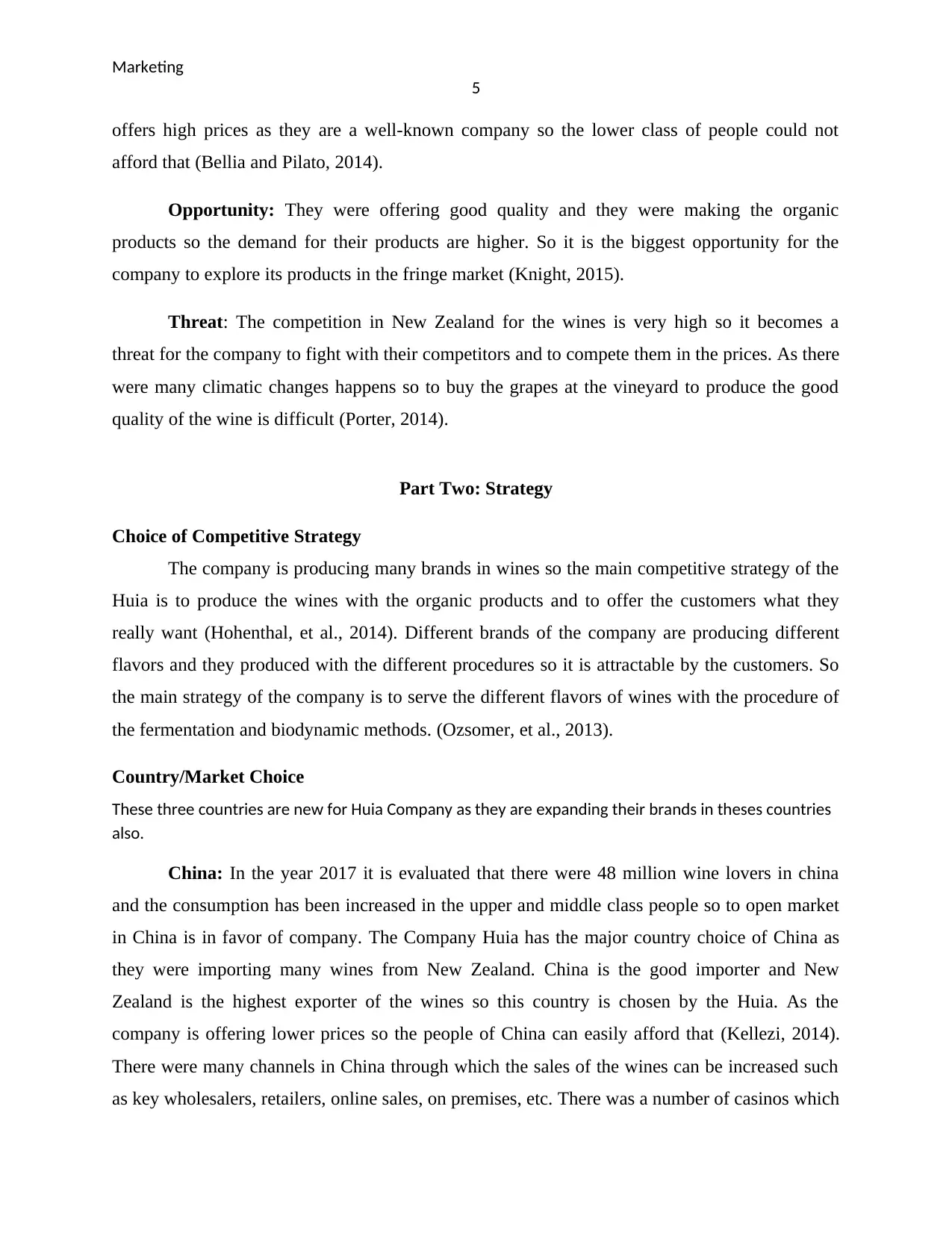
Marketing
5
offers high prices as they are a well-known company so the lower class of people could not
afford that (Bellia and Pilato, 2014).
Opportunity: They were offering good quality and they were making the organic
products so the demand for their products are higher. So it is the biggest opportunity for the
company to explore its products in the fringe market (Knight, 2015).
Threat: The competition in New Zealand for the wines is very high so it becomes a
threat for the company to fight with their competitors and to compete them in the prices. As there
were many climatic changes happens so to buy the grapes at the vineyard to produce the good
quality of the wine is difficult (Porter, 2014).
Part Two: Strategy
Choice of Competitive Strategy
The company is producing many brands in wines so the main competitive strategy of the
Huia is to produce the wines with the organic products and to offer the customers what they
really want (Hohenthal, et al., 2014). Different brands of the company are producing different
flavors and they produced with the different procedures so it is attractable by the customers. So
the main strategy of the company is to serve the different flavors of wines with the procedure of
the fermentation and biodynamic methods. (Ozsomer, et al., 2013).
Country/Market Choice
These three countries are new for Huia Company as they are expanding their brands in theses countries
also.
China: In the year 2017 it is evaluated that there were 48 million wine lovers in china
and the consumption has been increased in the upper and middle class people so to open market
in China is in favor of company. The Company Huia has the major country choice of China as
they were importing many wines from New Zealand. China is the good importer and New
Zealand is the highest exporter of the wines so this country is chosen by the Huia. As the
company is offering lower prices so the people of China can easily afford that (Kellezi, 2014).
There were many channels in China through which the sales of the wines can be increased such
as key wholesalers, retailers, online sales, on premises, etc. There was a number of casinos which
5
offers high prices as they are a well-known company so the lower class of people could not
afford that (Bellia and Pilato, 2014).
Opportunity: They were offering good quality and they were making the organic
products so the demand for their products are higher. So it is the biggest opportunity for the
company to explore its products in the fringe market (Knight, 2015).
Threat: The competition in New Zealand for the wines is very high so it becomes a
threat for the company to fight with their competitors and to compete them in the prices. As there
were many climatic changes happens so to buy the grapes at the vineyard to produce the good
quality of the wine is difficult (Porter, 2014).
Part Two: Strategy
Choice of Competitive Strategy
The company is producing many brands in wines so the main competitive strategy of the
Huia is to produce the wines with the organic products and to offer the customers what they
really want (Hohenthal, et al., 2014). Different brands of the company are producing different
flavors and they produced with the different procedures so it is attractable by the customers. So
the main strategy of the company is to serve the different flavors of wines with the procedure of
the fermentation and biodynamic methods. (Ozsomer, et al., 2013).
Country/Market Choice
These three countries are new for Huia Company as they are expanding their brands in theses countries
also.
China: In the year 2017 it is evaluated that there were 48 million wine lovers in china
and the consumption has been increased in the upper and middle class people so to open market
in China is in favor of company. The Company Huia has the major country choice of China as
they were importing many wines from New Zealand. China is the good importer and New
Zealand is the highest exporter of the wines so this country is chosen by the Huia. As the
company is offering lower prices so the people of China can easily afford that (Kellezi, 2014).
There were many channels in China through which the sales of the wines can be increased such
as key wholesalers, retailers, online sales, on premises, etc. There was a number of casinos which
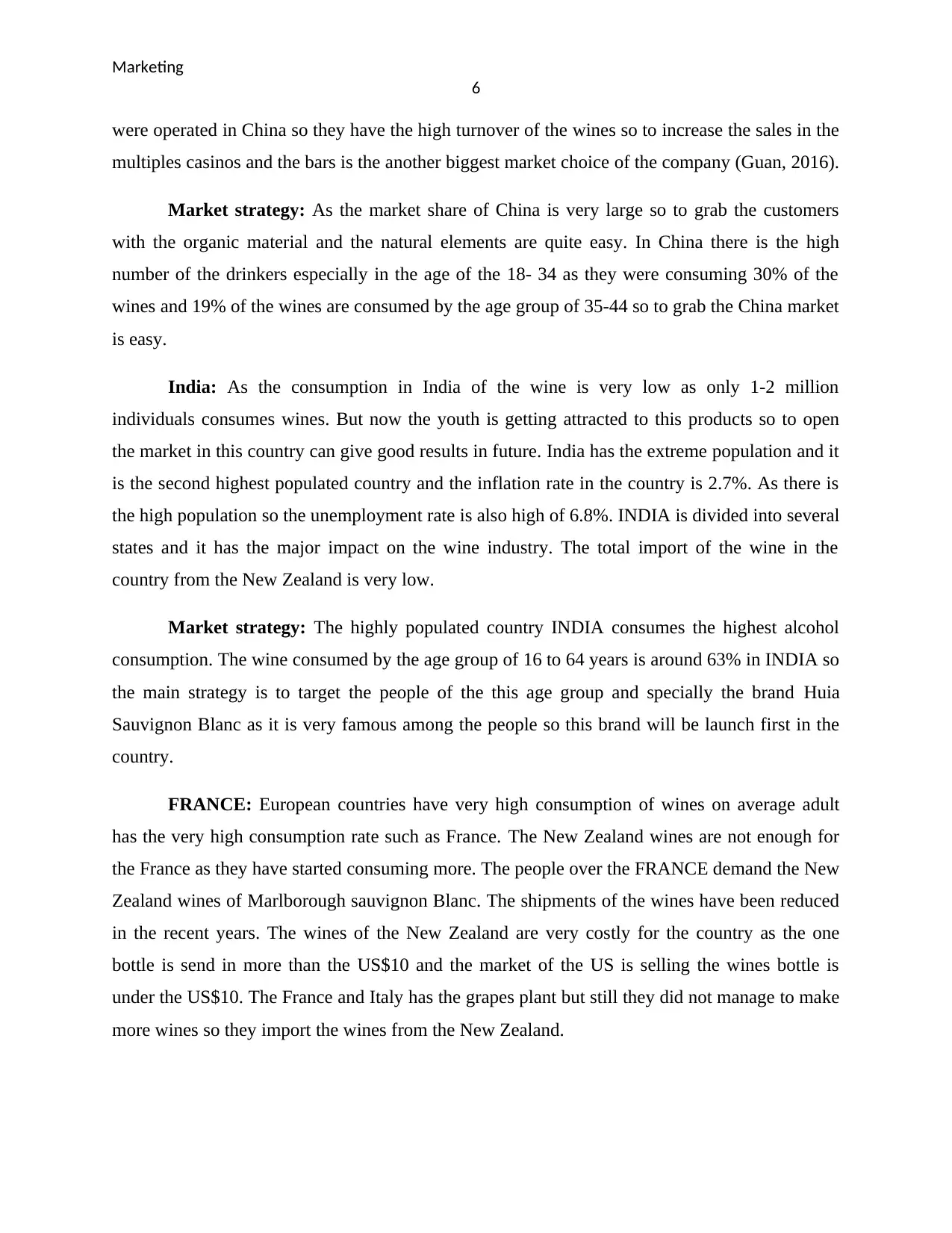
Marketing
6
were operated in China so they have the high turnover of the wines so to increase the sales in the
multiples casinos and the bars is the another biggest market choice of the company (Guan, 2016).
Market strategy: As the market share of China is very large so to grab the customers
with the organic material and the natural elements are quite easy. In China there is the high
number of the drinkers especially in the age of the 18- 34 as they were consuming 30% of the
wines and 19% of the wines are consumed by the age group of 35-44 so to grab the China market
is easy.
India: As the consumption in India of the wine is very low as only 1-2 million
individuals consumes wines. But now the youth is getting attracted to this products so to open
the market in this country can give good results in future. India has the extreme population and it
is the second highest populated country and the inflation rate in the country is 2.7%. As there is
the high population so the unemployment rate is also high of 6.8%. INDIA is divided into several
states and it has the major impact on the wine industry. The total import of the wine in the
country from the New Zealand is very low.
Market strategy: The highly populated country INDIA consumes the highest alcohol
consumption. The wine consumed by the age group of 16 to 64 years is around 63% in INDIA so
the main strategy is to target the people of the this age group and specially the brand Huia
Sauvignon Blanc as it is very famous among the people so this brand will be launch first in the
country.
FRANCE: European countries have very high consumption of wines on average adult
has the very high consumption rate such as France. The New Zealand wines are not enough for
the France as they have started consuming more. The people over the FRANCE demand the New
Zealand wines of Marlborough sauvignon Blanc. The shipments of the wines have been reduced
in the recent years. The wines of the New Zealand are very costly for the country as the one
bottle is send in more than the US$10 and the market of the US is selling the wines bottle is
under the US$10. The France and Italy has the grapes plant but still they did not manage to make
more wines so they import the wines from the New Zealand.
6
were operated in China so they have the high turnover of the wines so to increase the sales in the
multiples casinos and the bars is the another biggest market choice of the company (Guan, 2016).
Market strategy: As the market share of China is very large so to grab the customers
with the organic material and the natural elements are quite easy. In China there is the high
number of the drinkers especially in the age of the 18- 34 as they were consuming 30% of the
wines and 19% of the wines are consumed by the age group of 35-44 so to grab the China market
is easy.
India: As the consumption in India of the wine is very low as only 1-2 million
individuals consumes wines. But now the youth is getting attracted to this products so to open
the market in this country can give good results in future. India has the extreme population and it
is the second highest populated country and the inflation rate in the country is 2.7%. As there is
the high population so the unemployment rate is also high of 6.8%. INDIA is divided into several
states and it has the major impact on the wine industry. The total import of the wine in the
country from the New Zealand is very low.
Market strategy: The highly populated country INDIA consumes the highest alcohol
consumption. The wine consumed by the age group of 16 to 64 years is around 63% in INDIA so
the main strategy is to target the people of the this age group and specially the brand Huia
Sauvignon Blanc as it is very famous among the people so this brand will be launch first in the
country.
FRANCE: European countries have very high consumption of wines on average adult
has the very high consumption rate such as France. The New Zealand wines are not enough for
the France as they have started consuming more. The people over the FRANCE demand the New
Zealand wines of Marlborough sauvignon Blanc. The shipments of the wines have been reduced
in the recent years. The wines of the New Zealand are very costly for the country as the one
bottle is send in more than the US$10 and the market of the US is selling the wines bottle is
under the US$10. The France and Italy has the grapes plant but still they did not manage to make
more wines so they import the wines from the New Zealand.
Paraphrase This Document
Need a fresh take? Get an instant paraphrase of this document with our AI Paraphraser
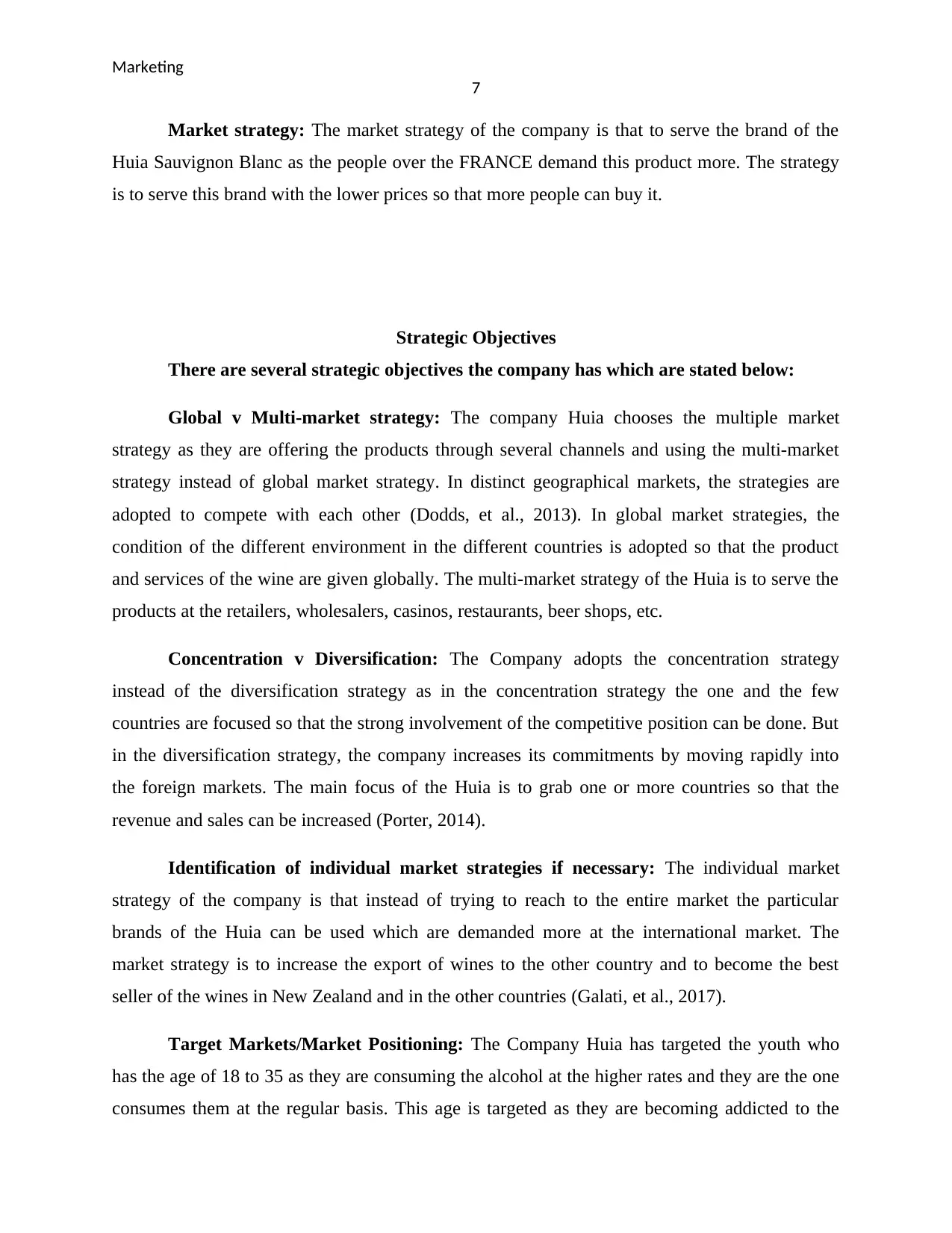
Marketing
7
Market strategy: The market strategy of the company is that to serve the brand of the
Huia Sauvignon Blanc as the people over the FRANCE demand this product more. The strategy
is to serve this brand with the lower prices so that more people can buy it.
Strategic Objectives
There are several strategic objectives the company has which are stated below:
Global v Multi-market strategy: The company Huia chooses the multiple market
strategy as they are offering the products through several channels and using the multi-market
strategy instead of global market strategy. In distinct geographical markets, the strategies are
adopted to compete with each other (Dodds, et al., 2013). In global market strategies, the
condition of the different environment in the different countries is adopted so that the product
and services of the wine are given globally. The multi-market strategy of the Huia is to serve the
products at the retailers, wholesalers, casinos, restaurants, beer shops, etc.
Concentration v Diversification: The Company adopts the concentration strategy
instead of the diversification strategy as in the concentration strategy the one and the few
countries are focused so that the strong involvement of the competitive position can be done. But
in the diversification strategy, the company increases its commitments by moving rapidly into
the foreign markets. The main focus of the Huia is to grab one or more countries so that the
revenue and sales can be increased (Porter, 2014).
Identification of individual market strategies if necessary: The individual market
strategy of the company is that instead of trying to reach to the entire market the particular
brands of the Huia can be used which are demanded more at the international market. The
market strategy is to increase the export of wines to the other country and to become the best
seller of the wines in New Zealand and in the other countries (Galati, et al., 2017).
Target Markets/Market Positioning: The Company Huia has targeted the youth who
has the age of 18 to 35 as they are consuming the alcohol at the higher rates and they are the one
consumes them at the regular basis. This age is targeted as they are becoming addicted to the
7
Market strategy: The market strategy of the company is that to serve the brand of the
Huia Sauvignon Blanc as the people over the FRANCE demand this product more. The strategy
is to serve this brand with the lower prices so that more people can buy it.
Strategic Objectives
There are several strategic objectives the company has which are stated below:
Global v Multi-market strategy: The company Huia chooses the multiple market
strategy as they are offering the products through several channels and using the multi-market
strategy instead of global market strategy. In distinct geographical markets, the strategies are
adopted to compete with each other (Dodds, et al., 2013). In global market strategies, the
condition of the different environment in the different countries is adopted so that the product
and services of the wine are given globally. The multi-market strategy of the Huia is to serve the
products at the retailers, wholesalers, casinos, restaurants, beer shops, etc.
Concentration v Diversification: The Company adopts the concentration strategy
instead of the diversification strategy as in the concentration strategy the one and the few
countries are focused so that the strong involvement of the competitive position can be done. But
in the diversification strategy, the company increases its commitments by moving rapidly into
the foreign markets. The main focus of the Huia is to grab one or more countries so that the
revenue and sales can be increased (Porter, 2014).
Identification of individual market strategies if necessary: The individual market
strategy of the company is that instead of trying to reach to the entire market the particular
brands of the Huia can be used which are demanded more at the international market. The
market strategy is to increase the export of wines to the other country and to become the best
seller of the wines in New Zealand and in the other countries (Galati, et al., 2017).
Target Markets/Market Positioning: The Company Huia has targeted the youth who
has the age of 18 to 35 as they are consuming the alcohol at the higher rates and they are the one
consumes them at the regular basis. This age is targeted as they are becoming addicted to the
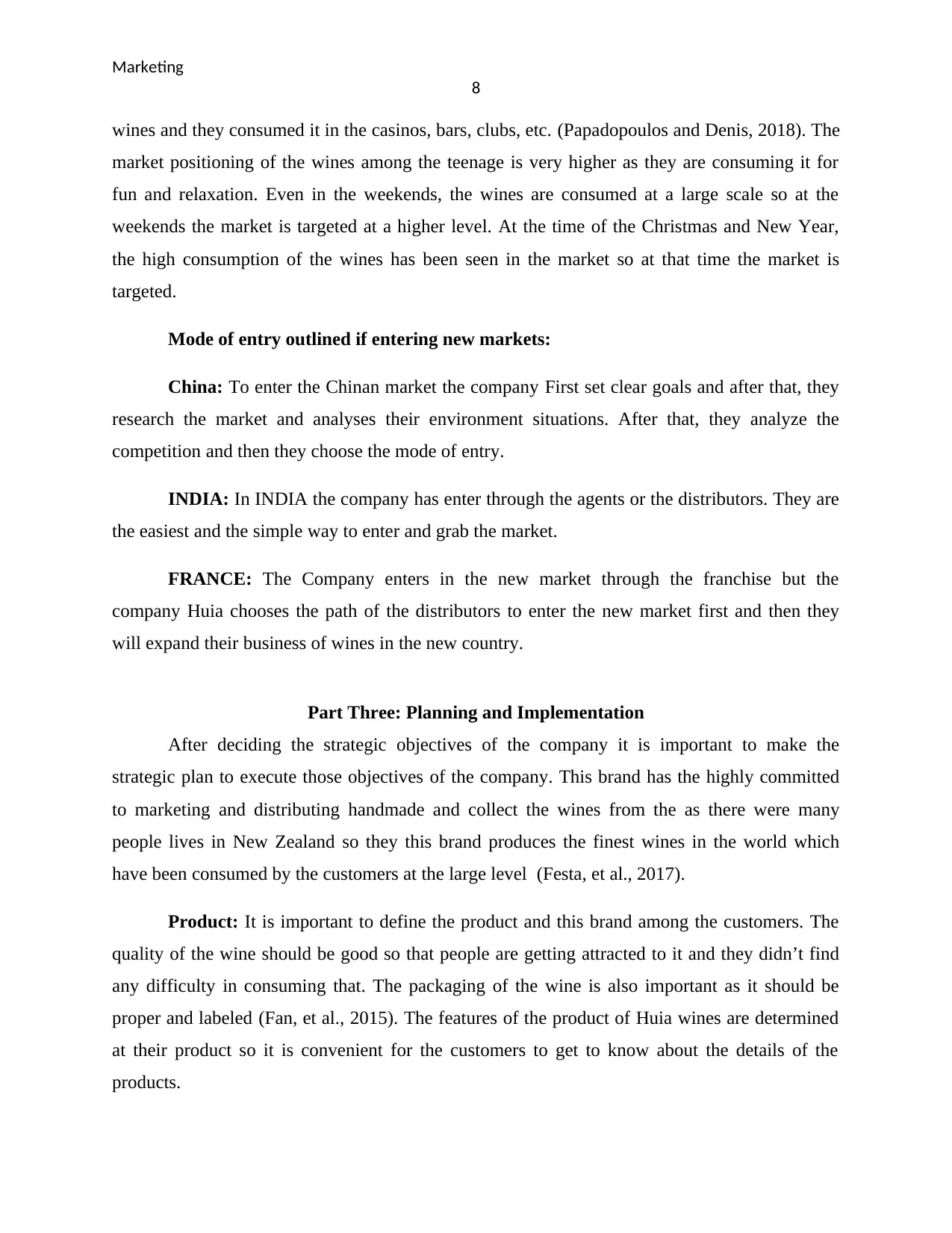
Marketing
8
wines and they consumed it in the casinos, bars, clubs, etc. (Papadopoulos and Denis, 2018). The
market positioning of the wines among the teenage is very higher as they are consuming it for
fun and relaxation. Even in the weekends, the wines are consumed at a large scale so at the
weekends the market is targeted at a higher level. At the time of the Christmas and New Year,
the high consumption of the wines has been seen in the market so at that time the market is
targeted.
Mode of entry outlined if entering new markets:
China: To enter the Chinan market the company First set clear goals and after that, they
research the market and analyses their environment situations. After that, they analyze the
competition and then they choose the mode of entry.
INDIA: In INDIA the company has enter through the agents or the distributors. They are
the easiest and the simple way to enter and grab the market.
FRANCE: The Company enters in the new market through the franchise but the
company Huia chooses the path of the distributors to enter the new market first and then they
will expand their business of wines in the new country.
Part Three: Planning and Implementation
After deciding the strategic objectives of the company it is important to make the
strategic plan to execute those objectives of the company. This brand has the highly committed
to marketing and distributing handmade and collect the wines from the as there were many
people lives in New Zealand so they this brand produces the finest wines in the world which
have been consumed by the customers at the large level (Festa, et al., 2017).
Product: It is important to define the product and this brand among the customers. The
quality of the wine should be good so that people are getting attracted to it and they didn’t find
any difficulty in consuming that. The packaging of the wine is also important as it should be
proper and labeled (Fan, et al., 2015). The features of the product of Huia wines are determined
at their product so it is convenient for the customers to get to know about the details of the
products.
8
wines and they consumed it in the casinos, bars, clubs, etc. (Papadopoulos and Denis, 2018). The
market positioning of the wines among the teenage is very higher as they are consuming it for
fun and relaxation. Even in the weekends, the wines are consumed at a large scale so at the
weekends the market is targeted at a higher level. At the time of the Christmas and New Year,
the high consumption of the wines has been seen in the market so at that time the market is
targeted.
Mode of entry outlined if entering new markets:
China: To enter the Chinan market the company First set clear goals and after that, they
research the market and analyses their environment situations. After that, they analyze the
competition and then they choose the mode of entry.
INDIA: In INDIA the company has enter through the agents or the distributors. They are
the easiest and the simple way to enter and grab the market.
FRANCE: The Company enters in the new market through the franchise but the
company Huia chooses the path of the distributors to enter the new market first and then they
will expand their business of wines in the new country.
Part Three: Planning and Implementation
After deciding the strategic objectives of the company it is important to make the
strategic plan to execute those objectives of the company. This brand has the highly committed
to marketing and distributing handmade and collect the wines from the as there were many
people lives in New Zealand so they this brand produces the finest wines in the world which
have been consumed by the customers at the large level (Festa, et al., 2017).
Product: It is important to define the product and this brand among the customers. The
quality of the wine should be good so that people are getting attracted to it and they didn’t find
any difficulty in consuming that. The packaging of the wine is also important as it should be
proper and labeled (Fan, et al., 2015). The features of the product of Huia wines are determined
at their product so it is convenient for the customers to get to know about the details of the
products.
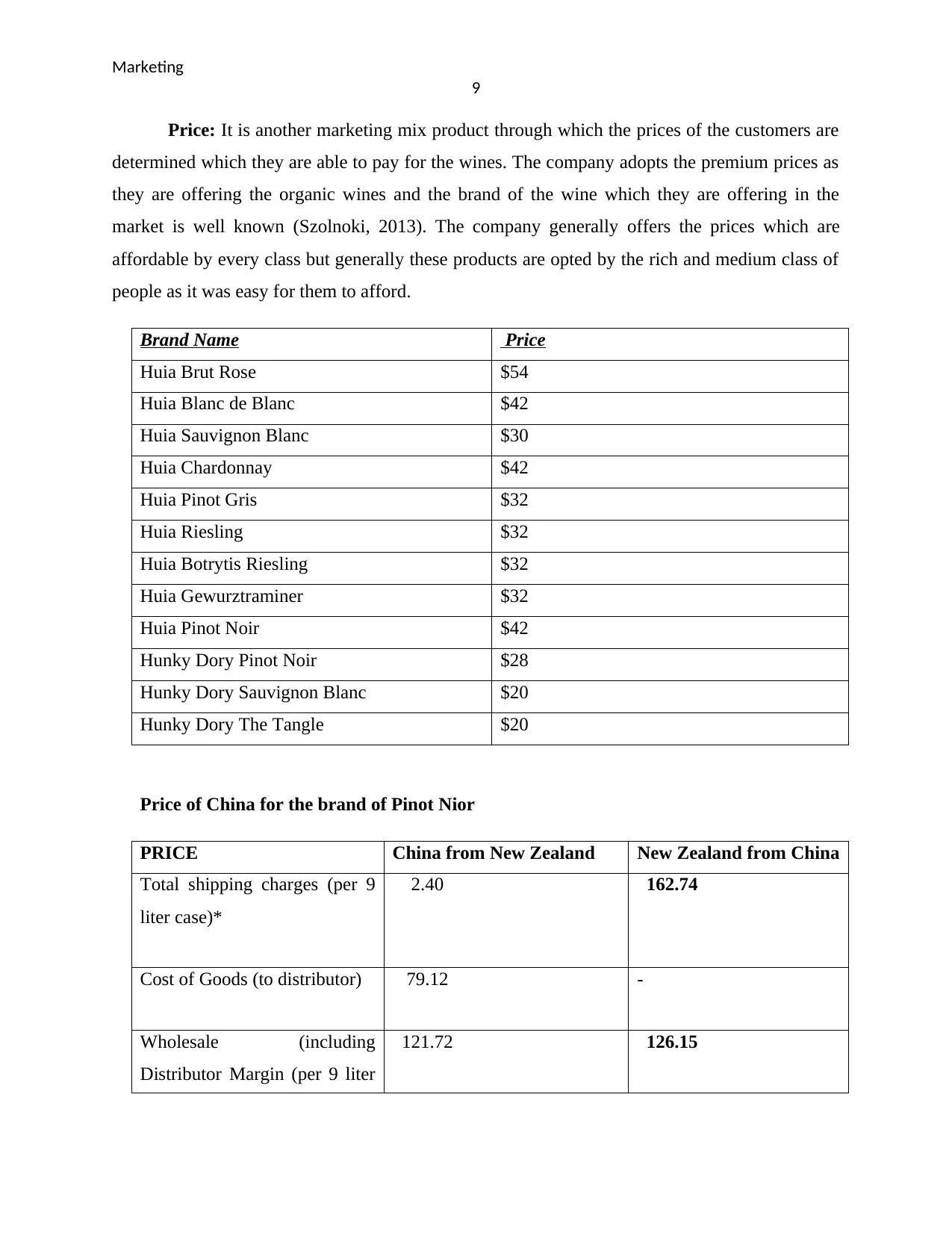
Marketing
9
Price: It is another marketing mix product through which the prices of the customers are
determined which they are able to pay for the wines. The company adopts the premium prices as
they are offering the organic wines and the brand of the wine which they are offering in the
market is well known (Szolnoki, 2013). The company generally offers the prices which are
affordable by every class but generally these products are opted by the rich and medium class of
people as it was easy for them to afford.
Brand Name Price
Huia Brut Rose $54
Huia Blanc de Blanc $42
Huia Sauvignon Blanc $30
Huia Chardonnay $42
Huia Pinot Gris $32
Huia Riesling $32
Huia Botrytis Riesling $32
Huia Gewurztraminer $32
Huia Pinot Noir $42
Hunky Dory Pinot Noir $28
Hunky Dory Sauvignon Blanc $20
Hunky Dory The Tangle $20
Price of China for the brand of Pinot Nior
PRICE China from New Zealand New Zealand from China
Total shipping charges (per 9
liter case)*
2.40 162.74
Cost of Goods (to distributor) 79.12 -
Wholesale (including
Distributor Margin (per 9 liter
121.72 126.15
9
Price: It is another marketing mix product through which the prices of the customers are
determined which they are able to pay for the wines. The company adopts the premium prices as
they are offering the organic wines and the brand of the wine which they are offering in the
market is well known (Szolnoki, 2013). The company generally offers the prices which are
affordable by every class but generally these products are opted by the rich and medium class of
people as it was easy for them to afford.
Brand Name Price
Huia Brut Rose $54
Huia Blanc de Blanc $42
Huia Sauvignon Blanc $30
Huia Chardonnay $42
Huia Pinot Gris $32
Huia Riesling $32
Huia Botrytis Riesling $32
Huia Gewurztraminer $32
Huia Pinot Noir $42
Hunky Dory Pinot Noir $28
Hunky Dory Sauvignon Blanc $20
Hunky Dory The Tangle $20
Price of China for the brand of Pinot Nior
PRICE China from New Zealand New Zealand from China
Total shipping charges (per 9
liter case)*
2.40 162.74
Cost of Goods (to distributor) 79.12 -
Wholesale (including
Distributor Margin (per 9 liter
121.72 126.15
Secure Best Marks with AI Grader
Need help grading? Try our AI Grader for instant feedback on your assignments.
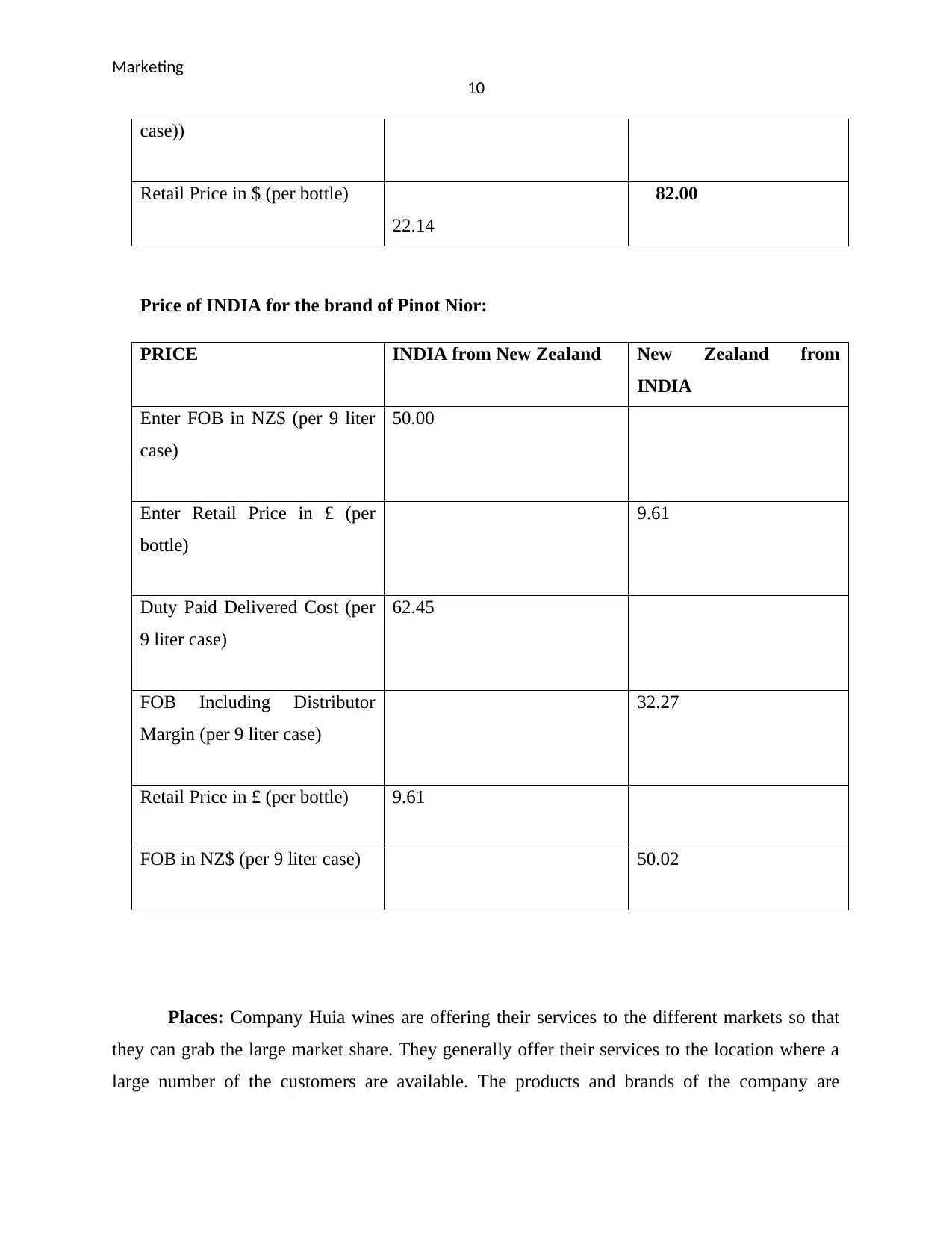
Marketing
10
case))
Retail Price in $ (per bottle) $ 22.14
22.14
82.00
Price of INDIA for the brand of Pinot Nior:
PRICE INDIA from New Zealand New Zealand from
INDIA
Enter FOB in NZ$ (per 9 liter
case)
50.00
Enter Retail Price in £ (per
bottle)
9.61
Duty Paid Delivered Cost (per
9 liter case)
62.45
FOB Including Distributor
Margin (per 9 liter case)
32.27
Retail Price in £ (per bottle) 9.61
FOB in NZ$ (per 9 liter case) 50.02
Places: Company Huia wines are offering their services to the different markets so that
they can grab the large market share. They generally offer their services to the location where a
large number of the customers are available. The products and brands of the company are
10
case))
Retail Price in $ (per bottle) $ 22.14
22.14
82.00
Price of INDIA for the brand of Pinot Nior:
PRICE INDIA from New Zealand New Zealand from
INDIA
Enter FOB in NZ$ (per 9 liter
case)
50.00
Enter Retail Price in £ (per
bottle)
9.61
Duty Paid Delivered Cost (per
9 liter case)
62.45
FOB Including Distributor
Margin (per 9 liter case)
32.27
Retail Price in £ (per bottle) 9.61
FOB in NZ$ (per 9 liter case) 50.02
Places: Company Huia wines are offering their services to the different markets so that
they can grab the large market share. They generally offer their services to the location where a
large number of the customers are available. The products and brands of the company are
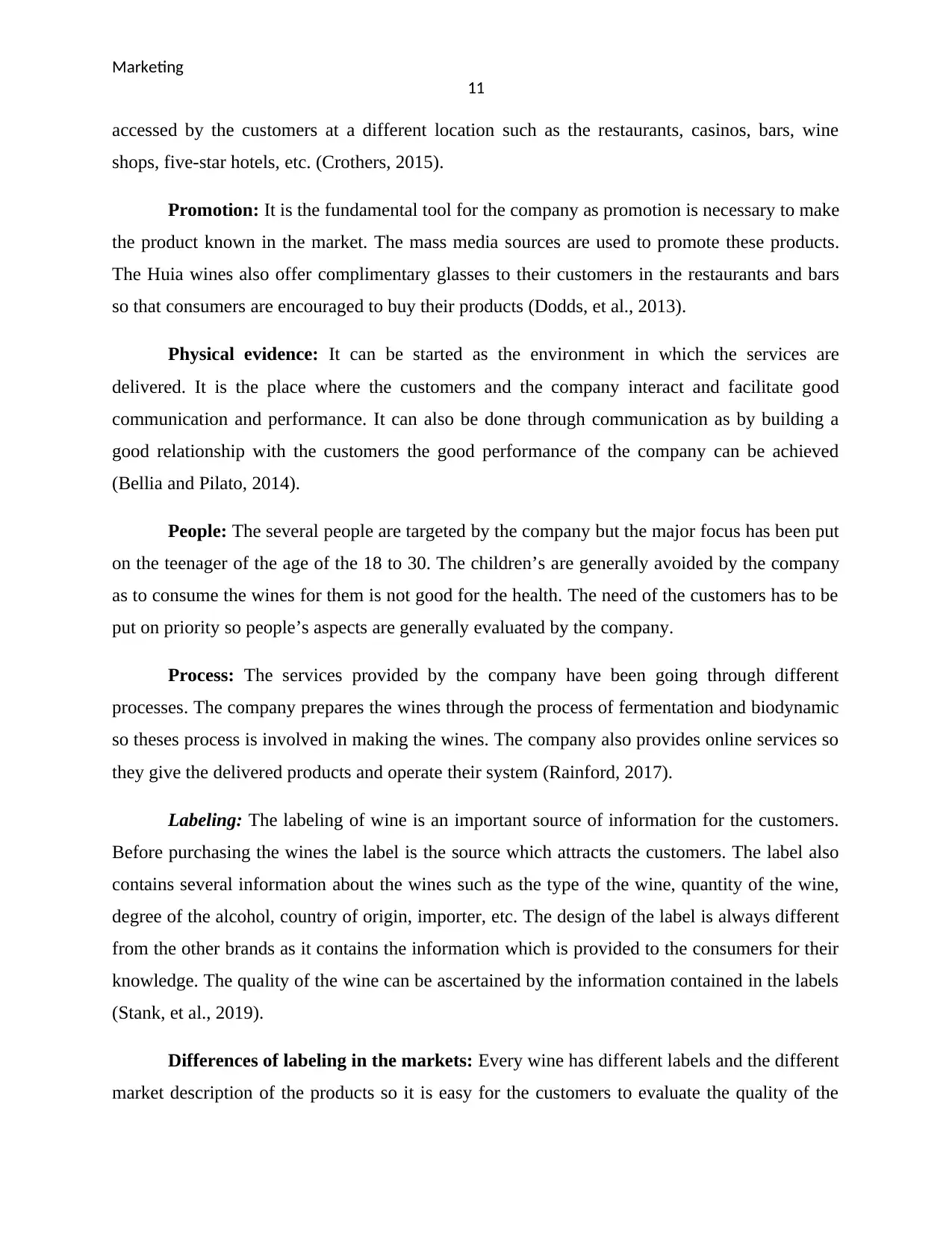
Marketing
11
accessed by the customers at a different location such as the restaurants, casinos, bars, wine
shops, five-star hotels, etc. (Crothers, 2015).
Promotion: It is the fundamental tool for the company as promotion is necessary to make
the product known in the market. The mass media sources are used to promote these products.
The Huia wines also offer complimentary glasses to their customers in the restaurants and bars
so that consumers are encouraged to buy their products (Dodds, et al., 2013).
Physical evidence: It can be started as the environment in which the services are
delivered. It is the place where the customers and the company interact and facilitate good
communication and performance. It can also be done through communication as by building a
good relationship with the customers the good performance of the company can be achieved
(Bellia and Pilato, 2014).
People: The several people are targeted by the company but the major focus has been put
on the teenager of the age of the 18 to 30. The children’s are generally avoided by the company
as to consume the wines for them is not good for the health. The need of the customers has to be
put on priority so people’s aspects are generally evaluated by the company.
Process: The services provided by the company have been going through different
processes. The company prepares the wines through the process of fermentation and biodynamic
so theses process is involved in making the wines. The company also provides online services so
they give the delivered products and operate their system (Rainford, 2017).
Labeling: The labeling of wine is an important source of information for the customers.
Before purchasing the wines the label is the source which attracts the customers. The label also
contains several information about the wines such as the type of the wine, quantity of the wine,
degree of the alcohol, country of origin, importer, etc. The design of the label is always different
from the other brands as it contains the information which is provided to the consumers for their
knowledge. The quality of the wine can be ascertained by the information contained in the labels
(Stank, et al., 2019).
Differences of labeling in the markets: Every wine has different labels and the different
market description of the products so it is easy for the customers to evaluate the quality of the
11
accessed by the customers at a different location such as the restaurants, casinos, bars, wine
shops, five-star hotels, etc. (Crothers, 2015).
Promotion: It is the fundamental tool for the company as promotion is necessary to make
the product known in the market. The mass media sources are used to promote these products.
The Huia wines also offer complimentary glasses to their customers in the restaurants and bars
so that consumers are encouraged to buy their products (Dodds, et al., 2013).
Physical evidence: It can be started as the environment in which the services are
delivered. It is the place where the customers and the company interact and facilitate good
communication and performance. It can also be done through communication as by building a
good relationship with the customers the good performance of the company can be achieved
(Bellia and Pilato, 2014).
People: The several people are targeted by the company but the major focus has been put
on the teenager of the age of the 18 to 30. The children’s are generally avoided by the company
as to consume the wines for them is not good for the health. The need of the customers has to be
put on priority so people’s aspects are generally evaluated by the company.
Process: The services provided by the company have been going through different
processes. The company prepares the wines through the process of fermentation and biodynamic
so theses process is involved in making the wines. The company also provides online services so
they give the delivered products and operate their system (Rainford, 2017).
Labeling: The labeling of wine is an important source of information for the customers.
Before purchasing the wines the label is the source which attracts the customers. The label also
contains several information about the wines such as the type of the wine, quantity of the wine,
degree of the alcohol, country of origin, importer, etc. The design of the label is always different
from the other brands as it contains the information which is provided to the consumers for their
knowledge. The quality of the wine can be ascertained by the information contained in the labels
(Stank, et al., 2019).
Differences of labeling in the markets: Every wine has different labels and the different
market description of the products so it is easy for the customers to evaluate the quality of the
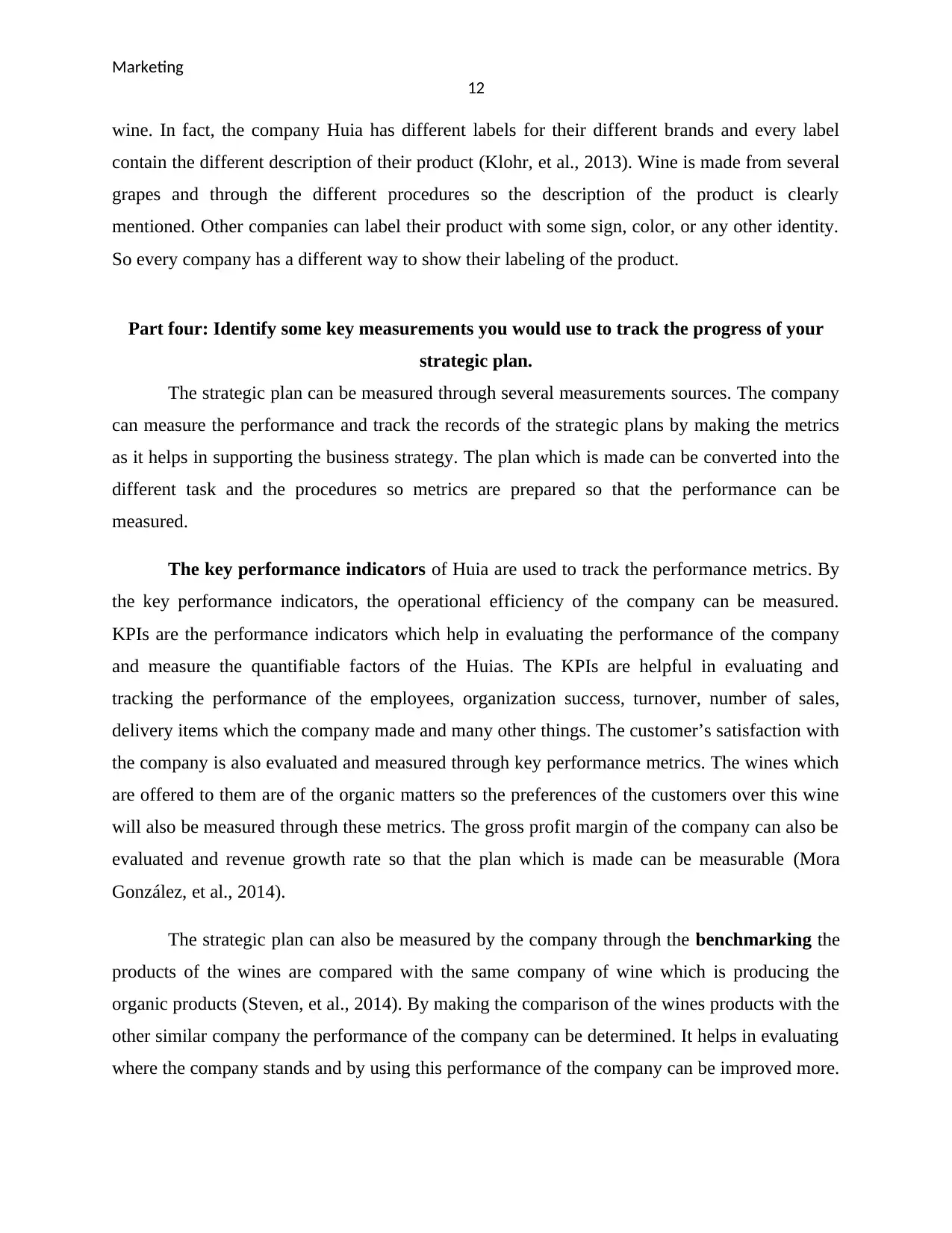
Marketing
12
wine. In fact, the company Huia has different labels for their different brands and every label
contain the different description of their product (Klohr, et al., 2013). Wine is made from several
grapes and through the different procedures so the description of the product is clearly
mentioned. Other companies can label their product with some sign, color, or any other identity.
So every company has a different way to show their labeling of the product.
Part four: Identify some key measurements you would use to track the progress of your
strategic plan.
The strategic plan can be measured through several measurements sources. The company
can measure the performance and track the records of the strategic plans by making the metrics
as it helps in supporting the business strategy. The plan which is made can be converted into the
different task and the procedures so metrics are prepared so that the performance can be
measured.
The key performance indicators of Huia are used to track the performance metrics. By
the key performance indicators, the operational efficiency of the company can be measured.
KPIs are the performance indicators which help in evaluating the performance of the company
and measure the quantifiable factors of the Huias. The KPIs are helpful in evaluating and
tracking the performance of the employees, organization success, turnover, number of sales,
delivery items which the company made and many other things. The customer’s satisfaction with
the company is also evaluated and measured through key performance metrics. The wines which
are offered to them are of the organic matters so the preferences of the customers over this wine
will also be measured through these metrics. The gross profit margin of the company can also be
evaluated and revenue growth rate so that the plan which is made can be measurable (Mora
González, et al., 2014).
The strategic plan can also be measured by the company through the benchmarking the
products of the wines are compared with the same company of wine which is producing the
organic products (Steven, et al., 2014). By making the comparison of the wines products with the
other similar company the performance of the company can be determined. It helps in evaluating
where the company stands and by using this performance of the company can be improved more.
12
wine. In fact, the company Huia has different labels for their different brands and every label
contain the different description of their product (Klohr, et al., 2013). Wine is made from several
grapes and through the different procedures so the description of the product is clearly
mentioned. Other companies can label their product with some sign, color, or any other identity.
So every company has a different way to show their labeling of the product.
Part four: Identify some key measurements you would use to track the progress of your
strategic plan.
The strategic plan can be measured through several measurements sources. The company
can measure the performance and track the records of the strategic plans by making the metrics
as it helps in supporting the business strategy. The plan which is made can be converted into the
different task and the procedures so metrics are prepared so that the performance can be
measured.
The key performance indicators of Huia are used to track the performance metrics. By
the key performance indicators, the operational efficiency of the company can be measured.
KPIs are the performance indicators which help in evaluating the performance of the company
and measure the quantifiable factors of the Huias. The KPIs are helpful in evaluating and
tracking the performance of the employees, organization success, turnover, number of sales,
delivery items which the company made and many other things. The customer’s satisfaction with
the company is also evaluated and measured through key performance metrics. The wines which
are offered to them are of the organic matters so the preferences of the customers over this wine
will also be measured through these metrics. The gross profit margin of the company can also be
evaluated and revenue growth rate so that the plan which is made can be measurable (Mora
González, et al., 2014).
The strategic plan can also be measured by the company through the benchmarking the
products of the wines are compared with the same company of wine which is producing the
organic products (Steven, et al., 2014). By making the comparison of the wines products with the
other similar company the performance of the company can be determined. It helps in evaluating
where the company stands and by using this performance of the company can be improved more.
Paraphrase This Document
Need a fresh take? Get an instant paraphrase of this document with our AI Paraphraser
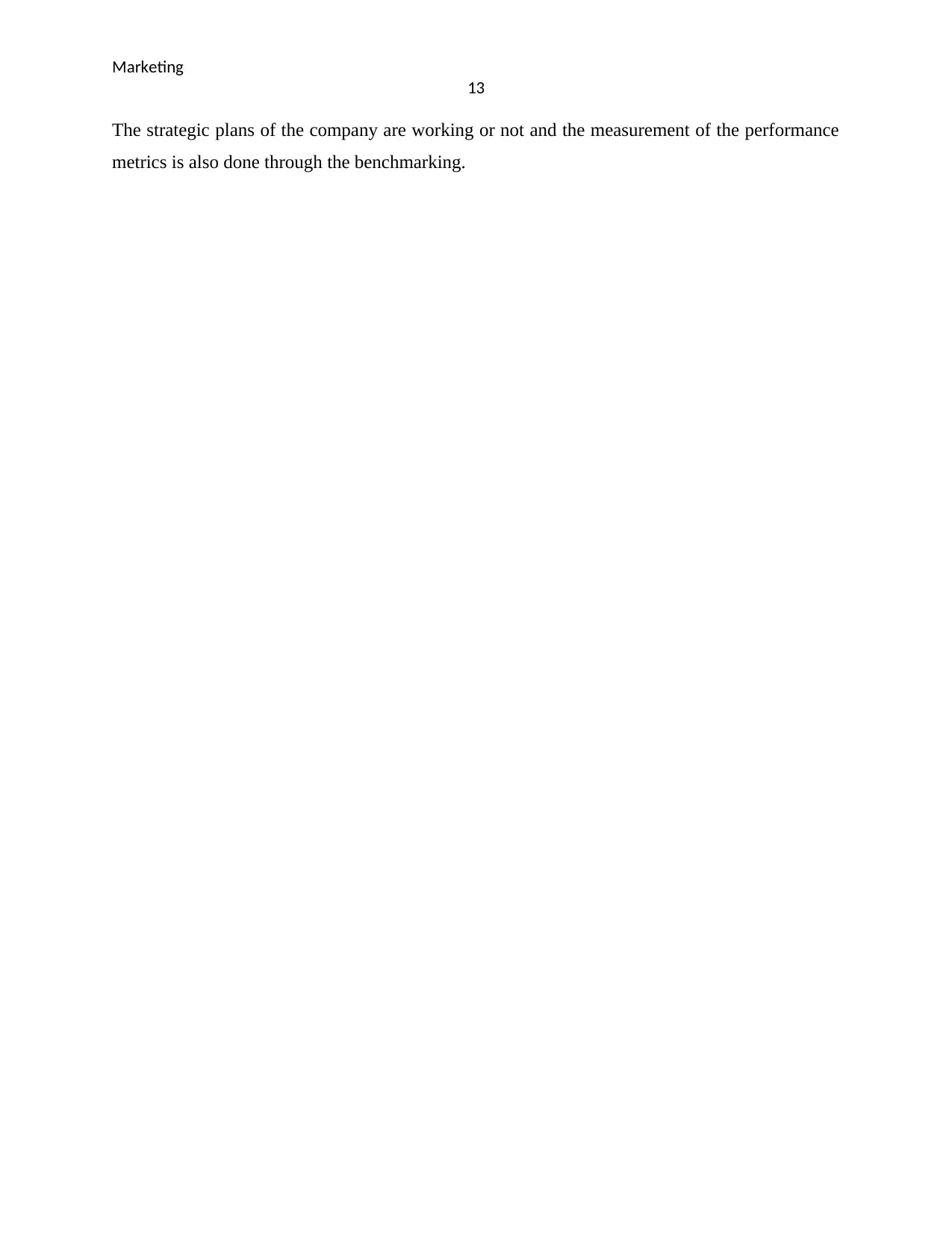
Marketing
13
The strategic plans of the company are working or not and the measurement of the performance
metrics is also done through the benchmarking.
13
The strategic plans of the company are working or not and the measurement of the performance
metrics is also done through the benchmarking.
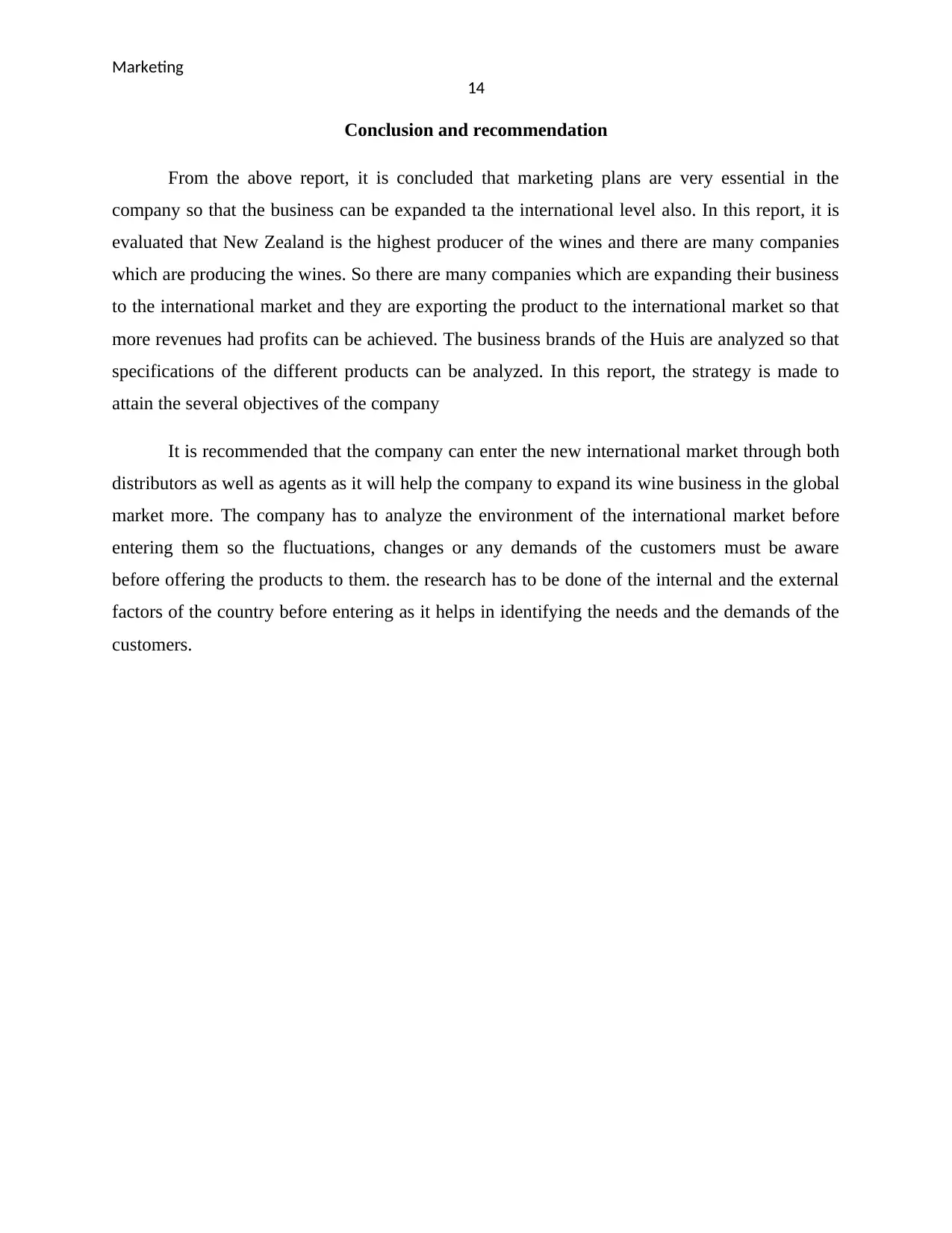
Marketing
14
Conclusion and recommendation
From the above report, it is concluded that marketing plans are very essential in the
company so that the business can be expanded ta the international level also. In this report, it is
evaluated that New Zealand is the highest producer of the wines and there are many companies
which are producing the wines. So there are many companies which are expanding their business
to the international market and they are exporting the product to the international market so that
more revenues had profits can be achieved. The business brands of the Huis are analyzed so that
specifications of the different products can be analyzed. In this report, the strategy is made to
attain the several objectives of the company
It is recommended that the company can enter the new international market through both
distributors as well as agents as it will help the company to expand its wine business in the global
market more. The company has to analyze the environment of the international market before
entering them so the fluctuations, changes or any demands of the customers must be aware
before offering the products to them. the research has to be done of the internal and the external
factors of the country before entering as it helps in identifying the needs and the demands of the
customers.
14
Conclusion and recommendation
From the above report, it is concluded that marketing plans are very essential in the
company so that the business can be expanded ta the international level also. In this report, it is
evaluated that New Zealand is the highest producer of the wines and there are many companies
which are producing the wines. So there are many companies which are expanding their business
to the international market and they are exporting the product to the international market so that
more revenues had profits can be achieved. The business brands of the Huis are analyzed so that
specifications of the different products can be analyzed. In this report, the strategy is made to
attain the several objectives of the company
It is recommended that the company can enter the new international market through both
distributors as well as agents as it will help the company to expand its wine business in the global
market more. The company has to analyze the environment of the international market before
entering them so the fluctuations, changes or any demands of the customers must be aware
before offering the products to them. the research has to be done of the internal and the external
factors of the country before entering as it helps in identifying the needs and the demands of the
customers.
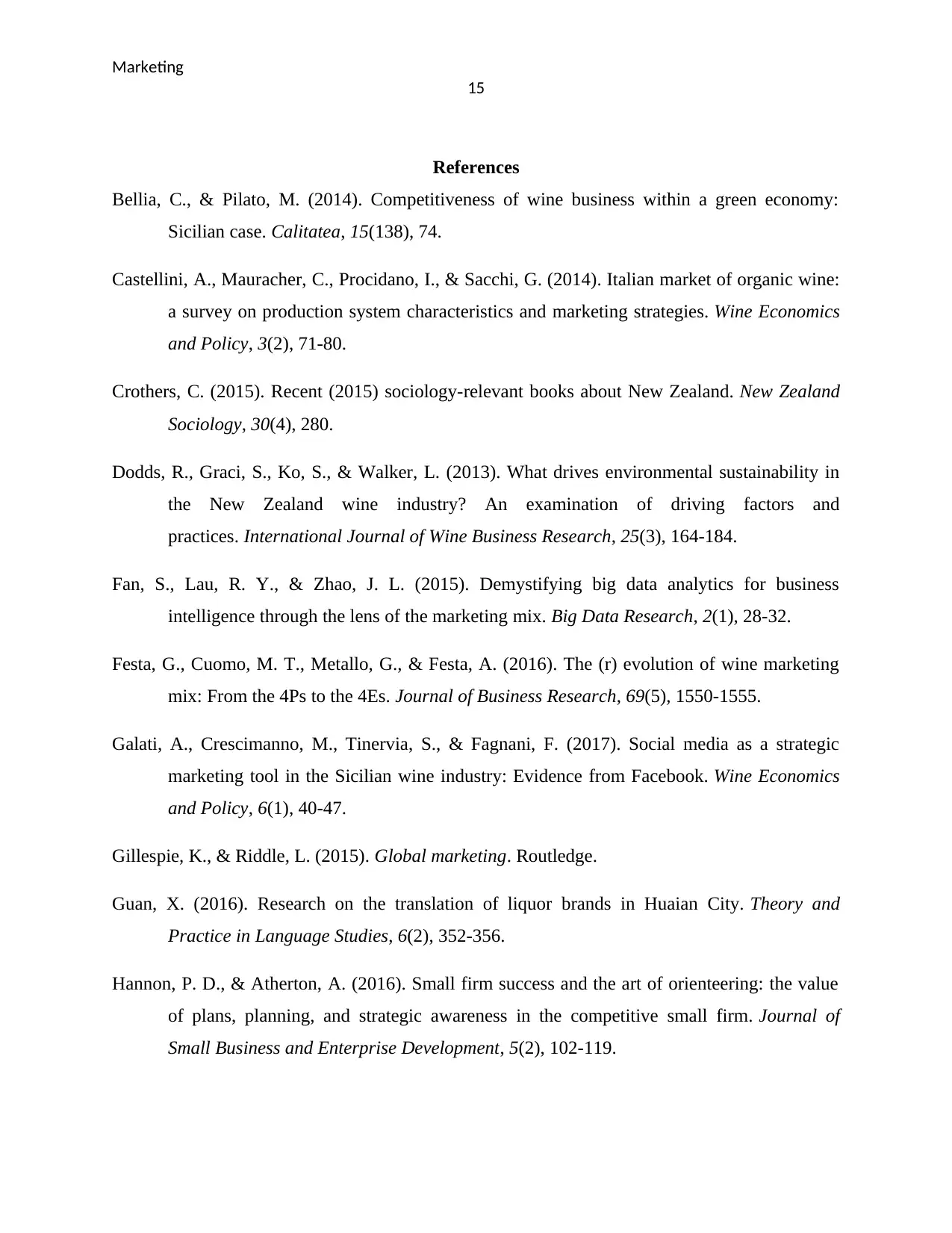
Marketing
15
References
Bellia, C., & Pilato, M. (2014). Competitiveness of wine business within a green economy:
Sicilian case. Calitatea, 15(138), 74.
Castellini, A., Mauracher, C., Procidano, I., & Sacchi, G. (2014). Italian market of organic wine:
a survey on production system characteristics and marketing strategies. Wine Economics
and Policy, 3(2), 71-80.
Crothers, C. (2015). Recent (2015) sociology-relevant books about New Zealand. New Zealand
Sociology, 30(4), 280.
Dodds, R., Graci, S., Ko, S., & Walker, L. (2013). What drives environmental sustainability in
the New Zealand wine industry? An examination of driving factors and
practices. International Journal of Wine Business Research, 25(3), 164-184.
Fan, S., Lau, R. Y., & Zhao, J. L. (2015). Demystifying big data analytics for business
intelligence through the lens of the marketing mix. Big Data Research, 2(1), 28-32.
Festa, G., Cuomo, M. T., Metallo, G., & Festa, A. (2016). The (r) evolution of wine marketing
mix: From the 4Ps to the 4Es. Journal of Business Research, 69(5), 1550-1555.
Galati, A., Crescimanno, M., Tinervia, S., & Fagnani, F. (2017). Social media as a strategic
marketing tool in the Sicilian wine industry: Evidence from Facebook. Wine Economics
and Policy, 6(1), 40-47.
Gillespie, K., & Riddle, L. (2015). Global marketing. Routledge.
Guan, X. (2016). Research on the translation of liquor brands in Huaian City. Theory and
Practice in Language Studies, 6(2), 352-356.
Hannon, P. D., & Atherton, A. (2016). Small firm success and the art of orienteering: the value
of plans, planning, and strategic awareness in the competitive small firm. Journal of
Small Business and Enterprise Development, 5(2), 102-119.
15
References
Bellia, C., & Pilato, M. (2014). Competitiveness of wine business within a green economy:
Sicilian case. Calitatea, 15(138), 74.
Castellini, A., Mauracher, C., Procidano, I., & Sacchi, G. (2014). Italian market of organic wine:
a survey on production system characteristics and marketing strategies. Wine Economics
and Policy, 3(2), 71-80.
Crothers, C. (2015). Recent (2015) sociology-relevant books about New Zealand. New Zealand
Sociology, 30(4), 280.
Dodds, R., Graci, S., Ko, S., & Walker, L. (2013). What drives environmental sustainability in
the New Zealand wine industry? An examination of driving factors and
practices. International Journal of Wine Business Research, 25(3), 164-184.
Fan, S., Lau, R. Y., & Zhao, J. L. (2015). Demystifying big data analytics for business
intelligence through the lens of the marketing mix. Big Data Research, 2(1), 28-32.
Festa, G., Cuomo, M. T., Metallo, G., & Festa, A. (2016). The (r) evolution of wine marketing
mix: From the 4Ps to the 4Es. Journal of Business Research, 69(5), 1550-1555.
Galati, A., Crescimanno, M., Tinervia, S., & Fagnani, F. (2017). Social media as a strategic
marketing tool in the Sicilian wine industry: Evidence from Facebook. Wine Economics
and Policy, 6(1), 40-47.
Gillespie, K., & Riddle, L. (2015). Global marketing. Routledge.
Guan, X. (2016). Research on the translation of liquor brands in Huaian City. Theory and
Practice in Language Studies, 6(2), 352-356.
Hannon, P. D., & Atherton, A. (2016). Small firm success and the art of orienteering: the value
of plans, planning, and strategic awareness in the competitive small firm. Journal of
Small Business and Enterprise Development, 5(2), 102-119.
Secure Best Marks with AI Grader
Need help grading? Try our AI Grader for instant feedback on your assignments.
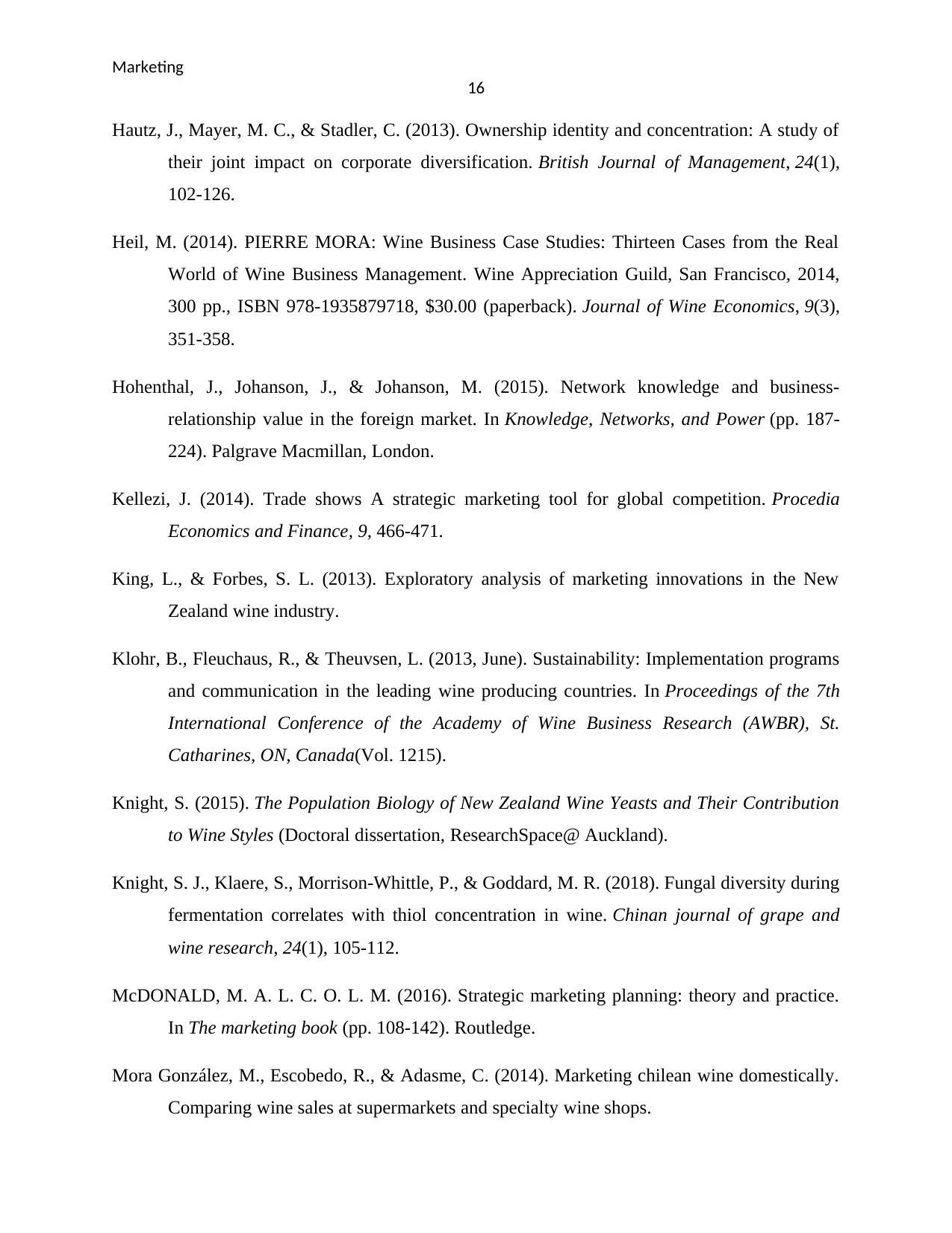
Marketing
16
Hautz, J., Mayer, M. C., & Stadler, C. (2013). Ownership identity and concentration: A study of
their joint impact on corporate diversification. British Journal of Management, 24(1),
102-126.
Heil, M. (2014). PIERRE MORA: Wine Business Case Studies: Thirteen Cases from the Real
World of Wine Business Management. Wine Appreciation Guild, San Francisco, 2014,
300 pp., ISBN 978-1935879718, $30.00 (paperback). Journal of Wine Economics, 9(3),
351-358.
Hohenthal, J., Johanson, J., & Johanson, M. (2015). Network knowledge and business-
relationship value in the foreign market. In Knowledge, Networks, and Power (pp. 187-
224). Palgrave Macmillan, London.
Kellezi, J. (2014). Trade shows A strategic marketing tool for global competition. Procedia
Economics and Finance, 9, 466-471.
King, L., & Forbes, S. L. (2013). Exploratory analysis of marketing innovations in the New
Zealand wine industry.
Klohr, B., Fleuchaus, R., & Theuvsen, L. (2013, June). Sustainability: Implementation programs
and communication in the leading wine producing countries. In Proceedings of the 7th
International Conference of the Academy of Wine Business Research (AWBR), St.
Catharines, ON, Canada(Vol. 1215).
Knight, S. (2015). The Population Biology of New Zealand Wine Yeasts and Their Contribution
to Wine Styles (Doctoral dissertation, ResearchSpace@ Auckland).
Knight, S. J., Klaere, S., Morrison‐Whittle, P., & Goddard, M. R. (2018). Fungal diversity during
fermentation correlates with thiol concentration in wine. Chinan journal of grape and
wine research, 24(1), 105-112.
McDONALD, M. A. L. C. O. L. M. (2016). Strategic marketing planning: theory and practice.
In The marketing book (pp. 108-142). Routledge.
Mora González, M., Escobedo, R., & Adasme, C. (2014). Marketing chilean wine domestically.
Comparing wine sales at supermarkets and specialty wine shops.
16
Hautz, J., Mayer, M. C., & Stadler, C. (2013). Ownership identity and concentration: A study of
their joint impact on corporate diversification. British Journal of Management, 24(1),
102-126.
Heil, M. (2014). PIERRE MORA: Wine Business Case Studies: Thirteen Cases from the Real
World of Wine Business Management. Wine Appreciation Guild, San Francisco, 2014,
300 pp., ISBN 978-1935879718, $30.00 (paperback). Journal of Wine Economics, 9(3),
351-358.
Hohenthal, J., Johanson, J., & Johanson, M. (2015). Network knowledge and business-
relationship value in the foreign market. In Knowledge, Networks, and Power (pp. 187-
224). Palgrave Macmillan, London.
Kellezi, J. (2014). Trade shows A strategic marketing tool for global competition. Procedia
Economics and Finance, 9, 466-471.
King, L., & Forbes, S. L. (2013). Exploratory analysis of marketing innovations in the New
Zealand wine industry.
Klohr, B., Fleuchaus, R., & Theuvsen, L. (2013, June). Sustainability: Implementation programs
and communication in the leading wine producing countries. In Proceedings of the 7th
International Conference of the Academy of Wine Business Research (AWBR), St.
Catharines, ON, Canada(Vol. 1215).
Knight, S. (2015). The Population Biology of New Zealand Wine Yeasts and Their Contribution
to Wine Styles (Doctoral dissertation, ResearchSpace@ Auckland).
Knight, S. J., Klaere, S., Morrison‐Whittle, P., & Goddard, M. R. (2018). Fungal diversity during
fermentation correlates with thiol concentration in wine. Chinan journal of grape and
wine research, 24(1), 105-112.
McDONALD, M. A. L. C. O. L. M. (2016). Strategic marketing planning: theory and practice.
In The marketing book (pp. 108-142). Routledge.
Mora González, M., Escobedo, R., & Adasme, C. (2014). Marketing chilean wine domestically.
Comparing wine sales at supermarkets and specialty wine shops.
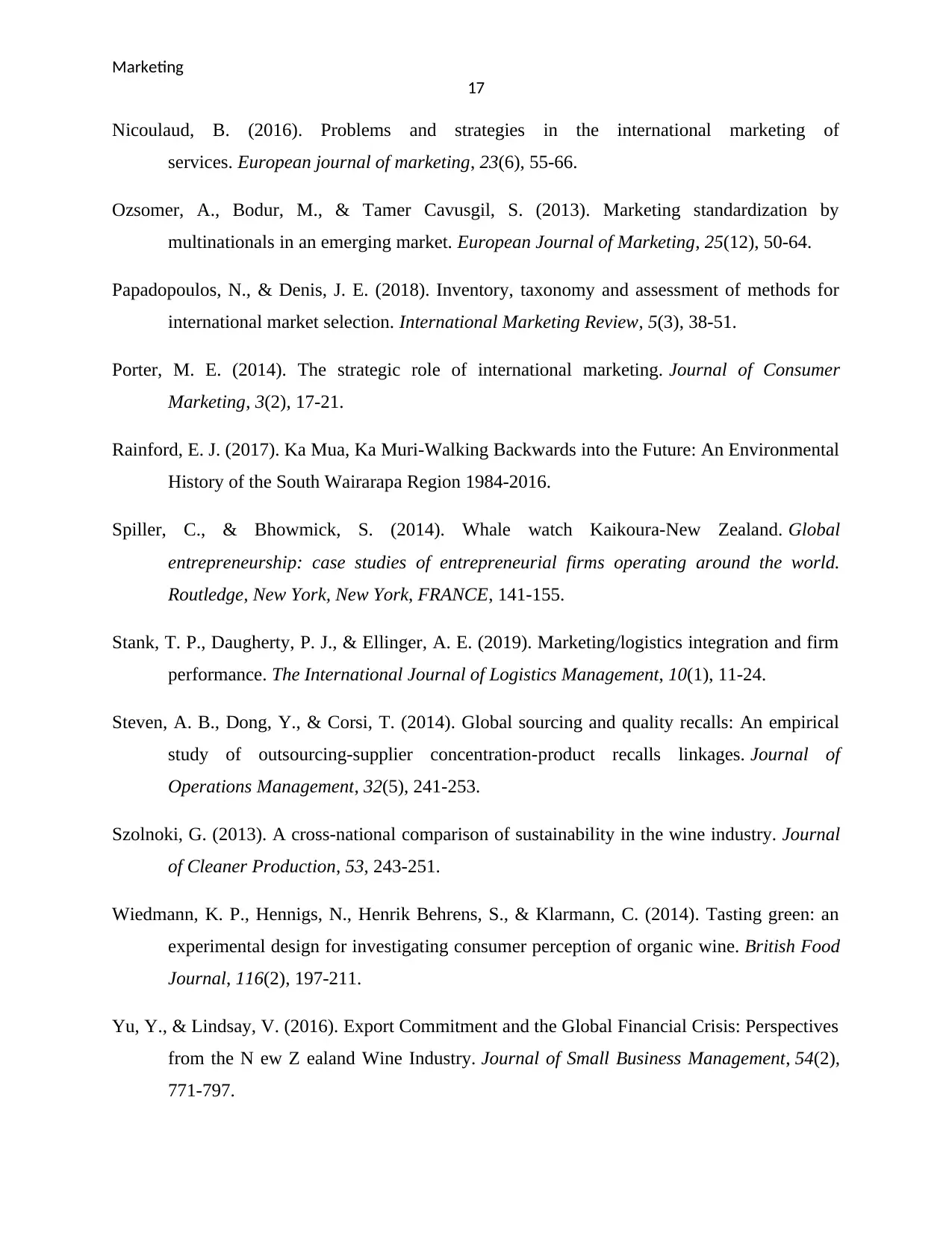
Marketing
17
Nicoulaud, B. (2016). Problems and strategies in the international marketing of
services. European journal of marketing, 23(6), 55-66.
Ozsomer, A., Bodur, M., & Tamer Cavusgil, S. (2013). Marketing standardization by
multinationals in an emerging market. European Journal of Marketing, 25(12), 50-64.
Papadopoulos, N., & Denis, J. E. (2018). Inventory, taxonomy and assessment of methods for
international market selection. International Marketing Review, 5(3), 38-51.
Porter, M. E. (2014). The strategic role of international marketing. Journal of Consumer
Marketing, 3(2), 17-21.
Rainford, E. J. (2017). Ka Mua, Ka Muri-Walking Backwards into the Future: An Environmental
History of the South Wairarapa Region 1984-2016.
Spiller, C., & Bhowmick, S. (2014). Whale watch Kaikoura-New Zealand. Global
entrepreneurship: case studies of entrepreneurial firms operating around the world.
Routledge, New York, New York, FRANCE, 141-155.
Stank, T. P., Daugherty, P. J., & Ellinger, A. E. (2019). Marketing/logistics integration and firm
performance. The International Journal of Logistics Management, 10(1), 11-24.
Steven, A. B., Dong, Y., & Corsi, T. (2014). Global sourcing and quality recalls: An empirical
study of outsourcing-supplier concentration-product recalls linkages. Journal of
Operations Management, 32(5), 241-253.
Szolnoki, G. (2013). A cross-national comparison of sustainability in the wine industry. Journal
of Cleaner Production, 53, 243-251.
Wiedmann, K. P., Hennigs, N., Henrik Behrens, S., & Klarmann, C. (2014). Tasting green: an
experimental design for investigating consumer perception of organic wine. British Food
Journal, 116(2), 197-211.
Yu, Y., & Lindsay, V. (2016). Export Commitment and the Global Financial Crisis: Perspectives
from the N ew Z ealand Wine Industry. Journal of Small Business Management, 54(2),
771-797.
17
Nicoulaud, B. (2016). Problems and strategies in the international marketing of
services. European journal of marketing, 23(6), 55-66.
Ozsomer, A., Bodur, M., & Tamer Cavusgil, S. (2013). Marketing standardization by
multinationals in an emerging market. European Journal of Marketing, 25(12), 50-64.
Papadopoulos, N., & Denis, J. E. (2018). Inventory, taxonomy and assessment of methods for
international market selection. International Marketing Review, 5(3), 38-51.
Porter, M. E. (2014). The strategic role of international marketing. Journal of Consumer
Marketing, 3(2), 17-21.
Rainford, E. J. (2017). Ka Mua, Ka Muri-Walking Backwards into the Future: An Environmental
History of the South Wairarapa Region 1984-2016.
Spiller, C., & Bhowmick, S. (2014). Whale watch Kaikoura-New Zealand. Global
entrepreneurship: case studies of entrepreneurial firms operating around the world.
Routledge, New York, New York, FRANCE, 141-155.
Stank, T. P., Daugherty, P. J., & Ellinger, A. E. (2019). Marketing/logistics integration and firm
performance. The International Journal of Logistics Management, 10(1), 11-24.
Steven, A. B., Dong, Y., & Corsi, T. (2014). Global sourcing and quality recalls: An empirical
study of outsourcing-supplier concentration-product recalls linkages. Journal of
Operations Management, 32(5), 241-253.
Szolnoki, G. (2013). A cross-national comparison of sustainability in the wine industry. Journal
of Cleaner Production, 53, 243-251.
Wiedmann, K. P., Hennigs, N., Henrik Behrens, S., & Klarmann, C. (2014). Tasting green: an
experimental design for investigating consumer perception of organic wine. British Food
Journal, 116(2), 197-211.
Yu, Y., & Lindsay, V. (2016). Export Commitment and the Global Financial Crisis: Perspectives
from the N ew Z ealand Wine Industry. Journal of Small Business Management, 54(2),
771-797.
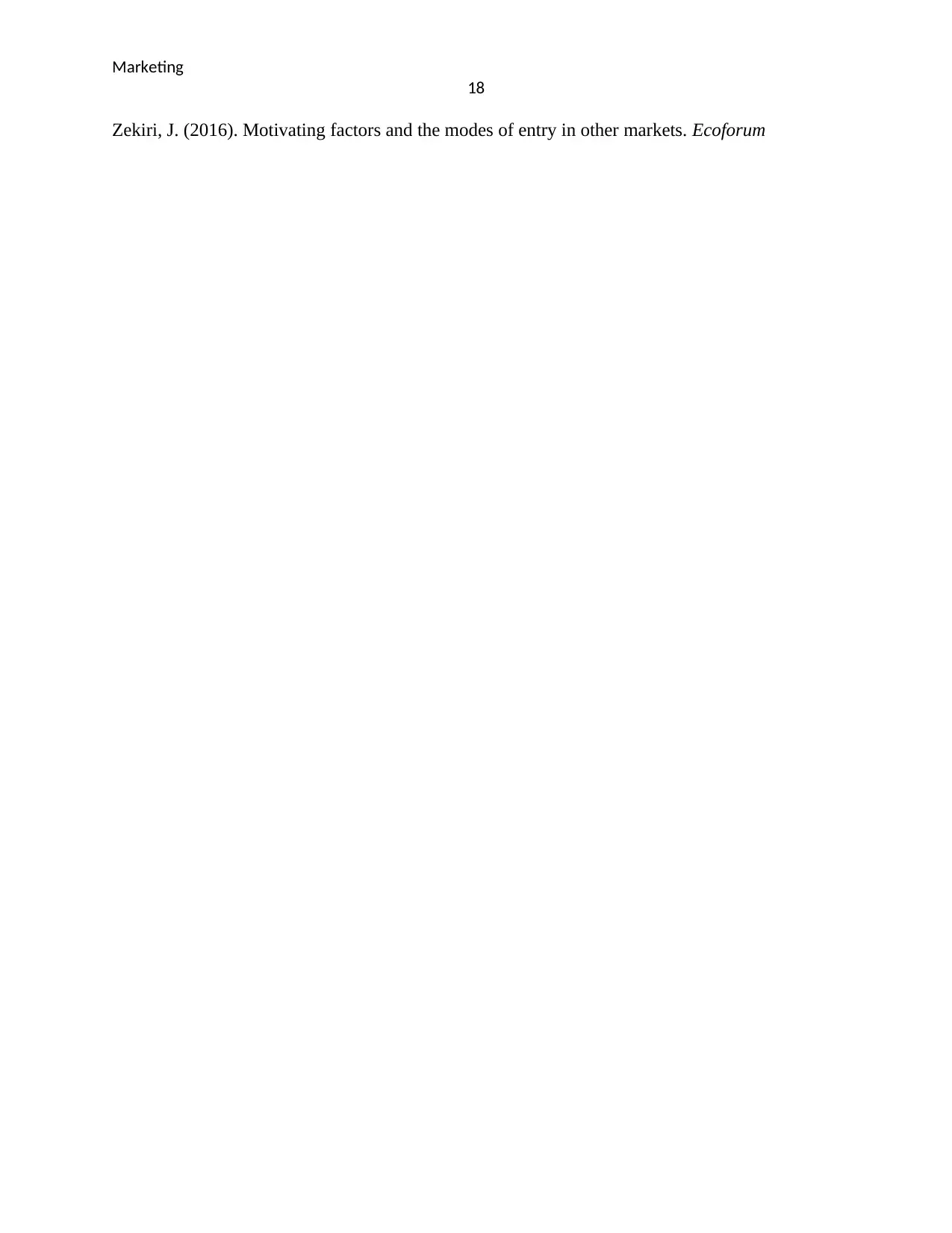
Marketing
18
Zekiri, J. (2016). Motivating factors and the modes of entry in other markets. Ecoforum
18
Zekiri, J. (2016). Motivating factors and the modes of entry in other markets. Ecoforum
1 out of 19
Your All-in-One AI-Powered Toolkit for Academic Success.
+13062052269
info@desklib.com
Available 24*7 on WhatsApp / Email
![[object Object]](/_next/static/media/star-bottom.7253800d.svg)
Unlock your academic potential
© 2024 | Zucol Services PVT LTD | All rights reserved.